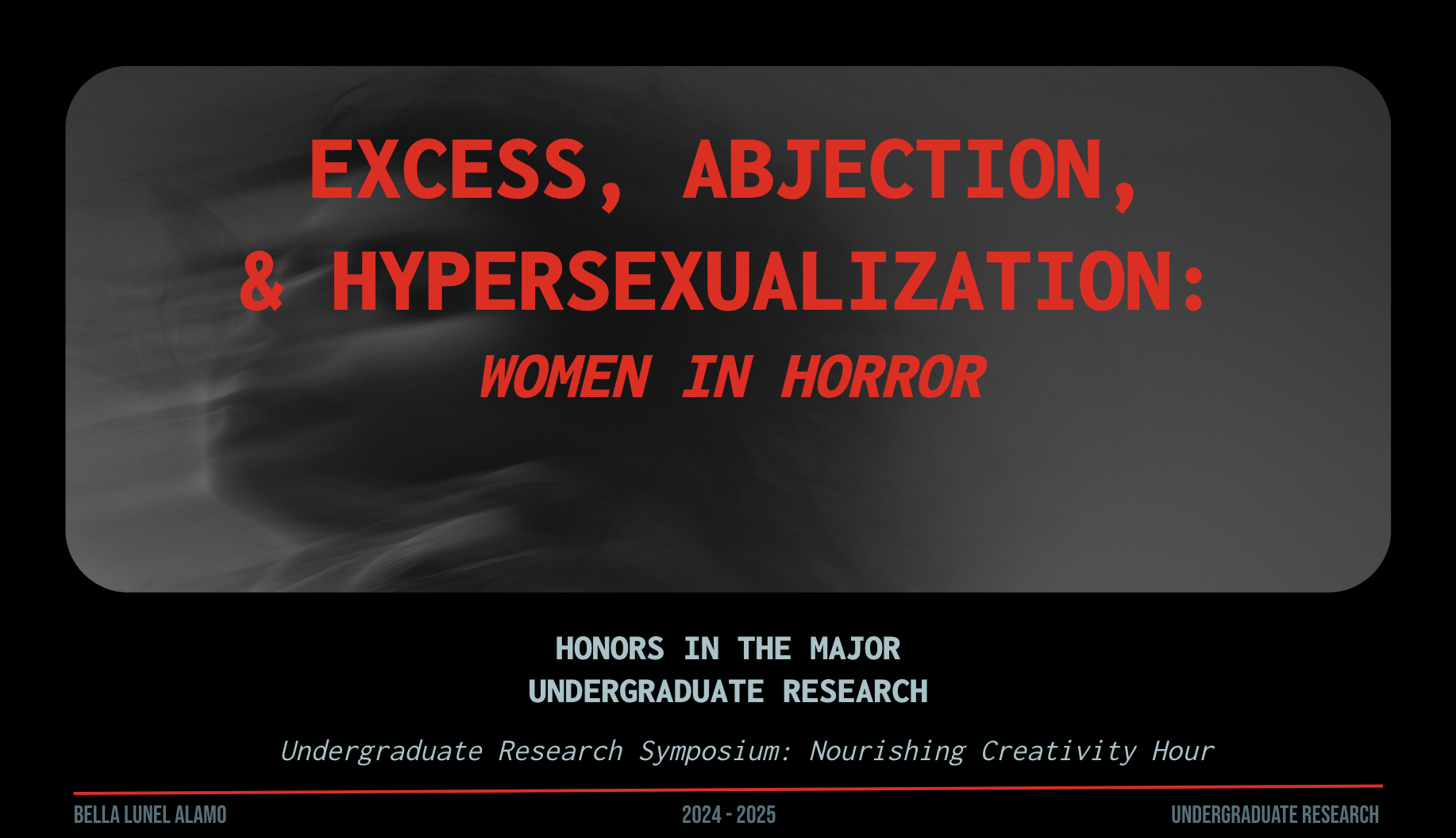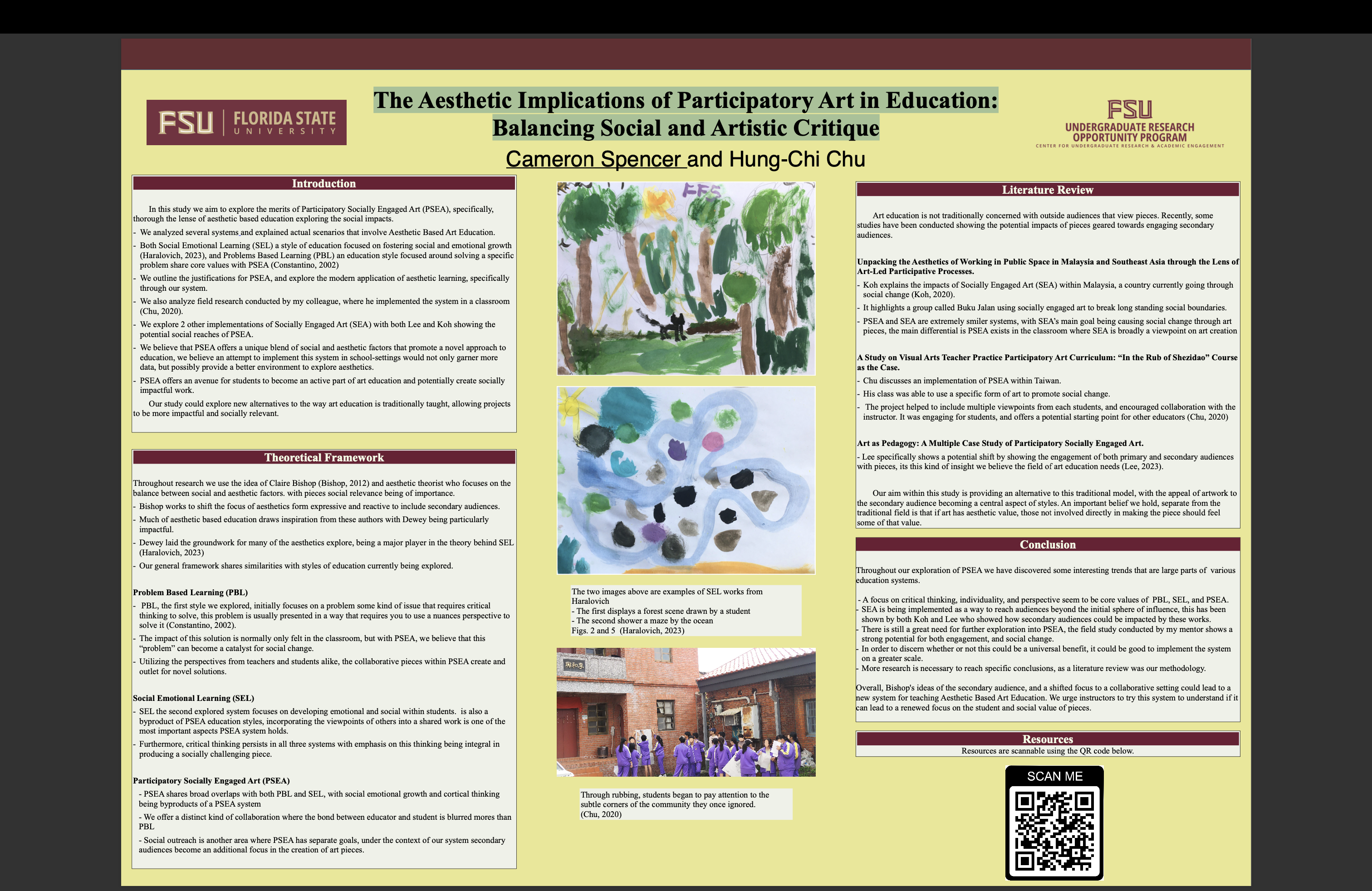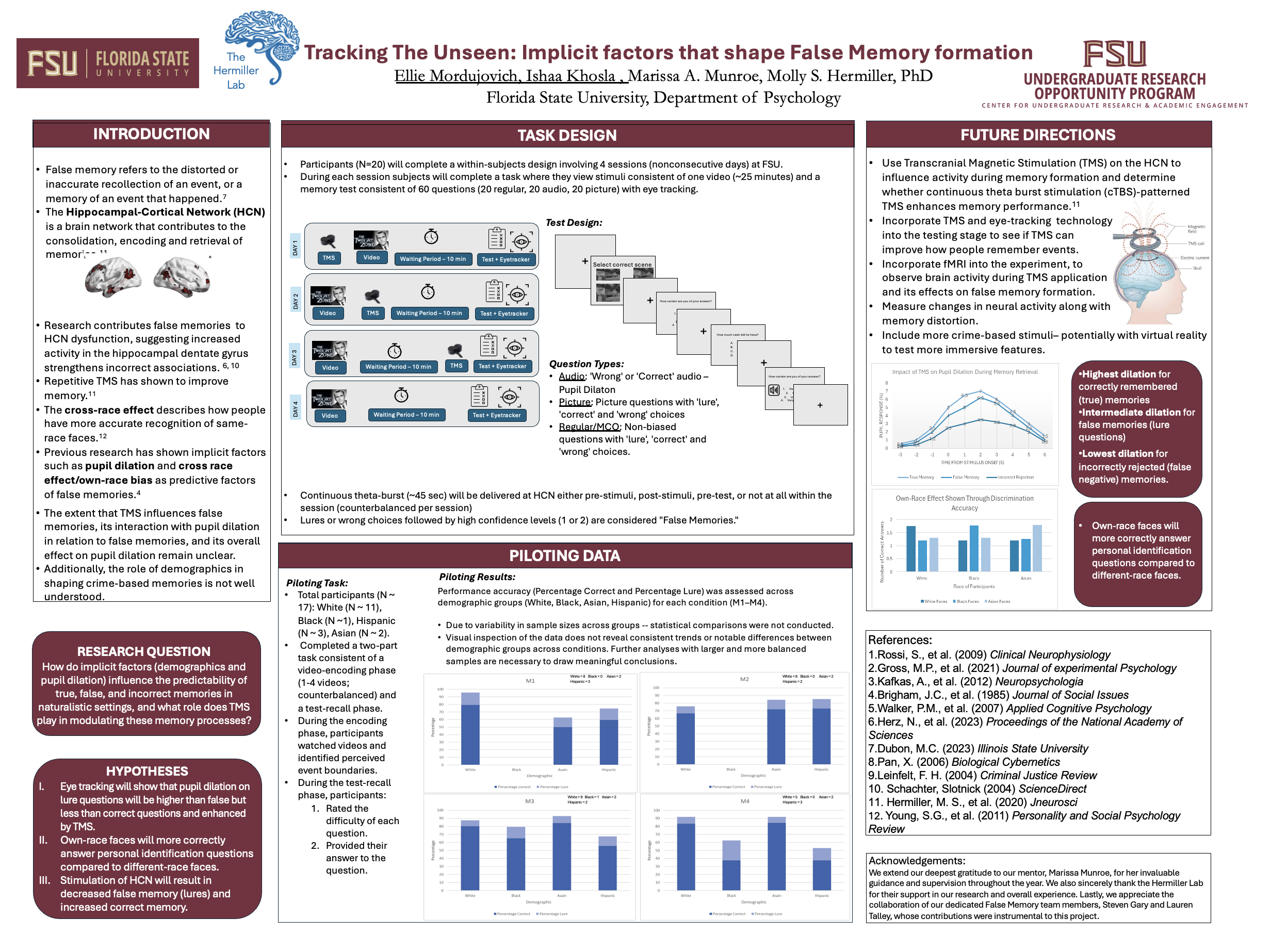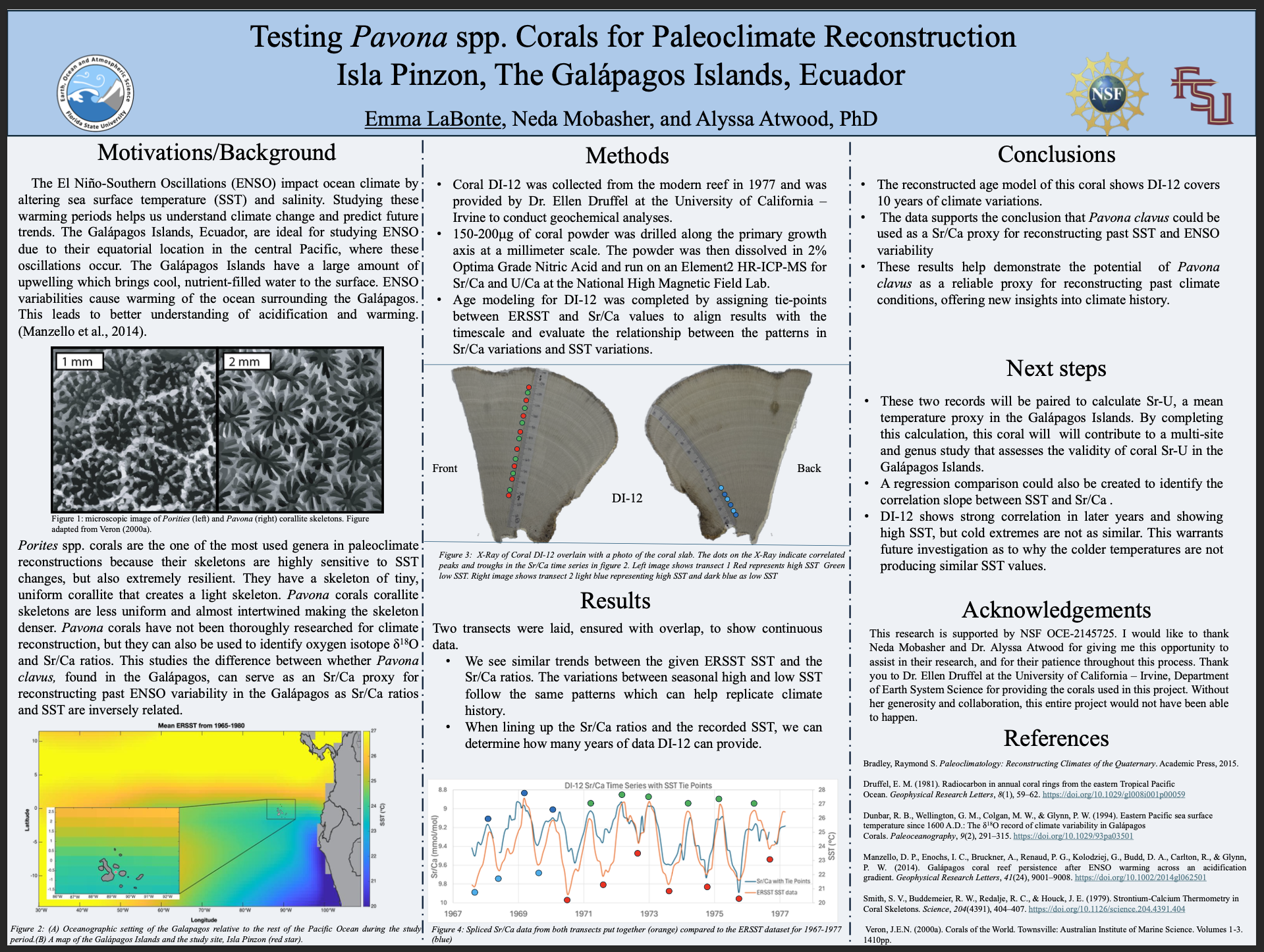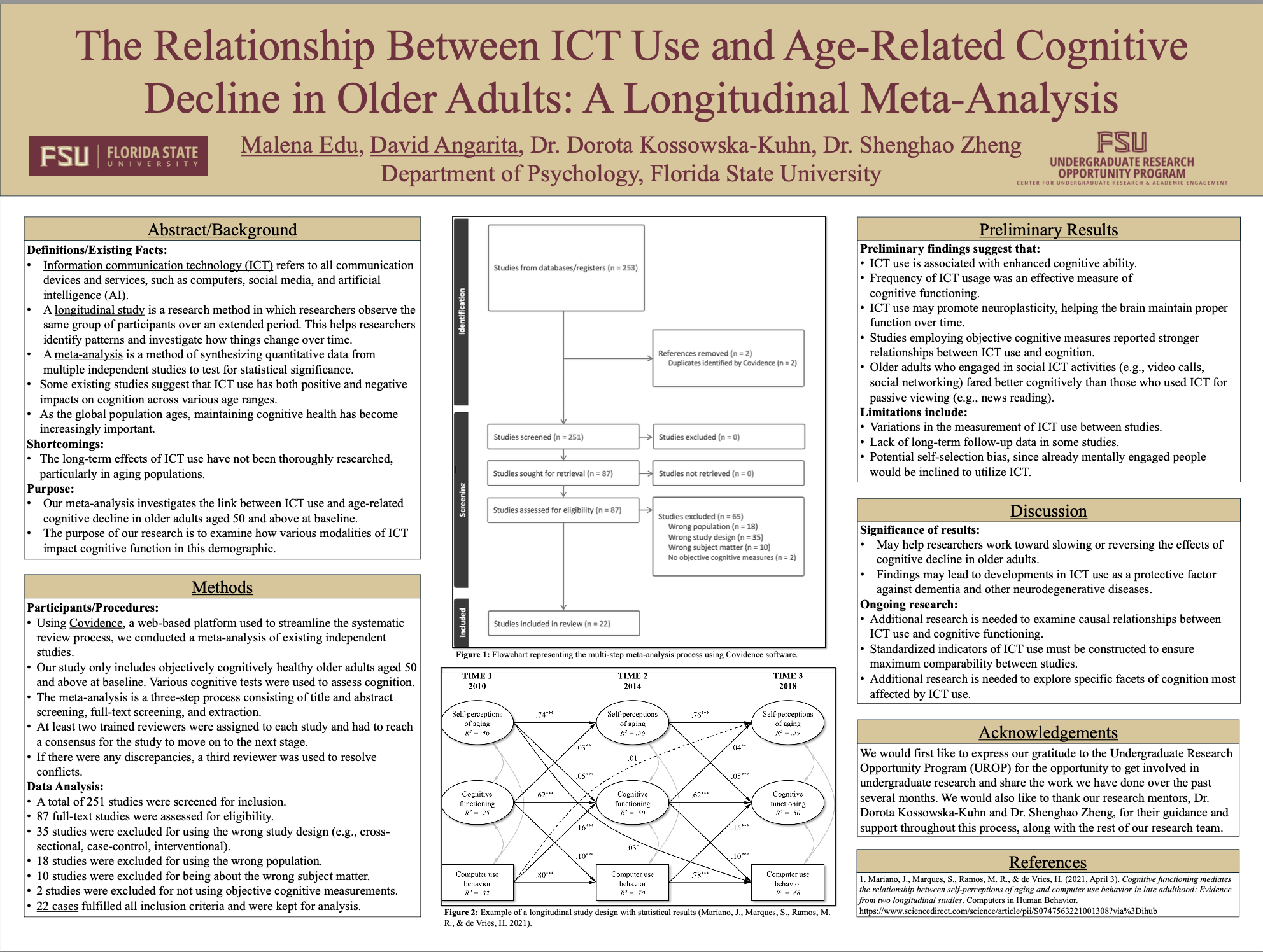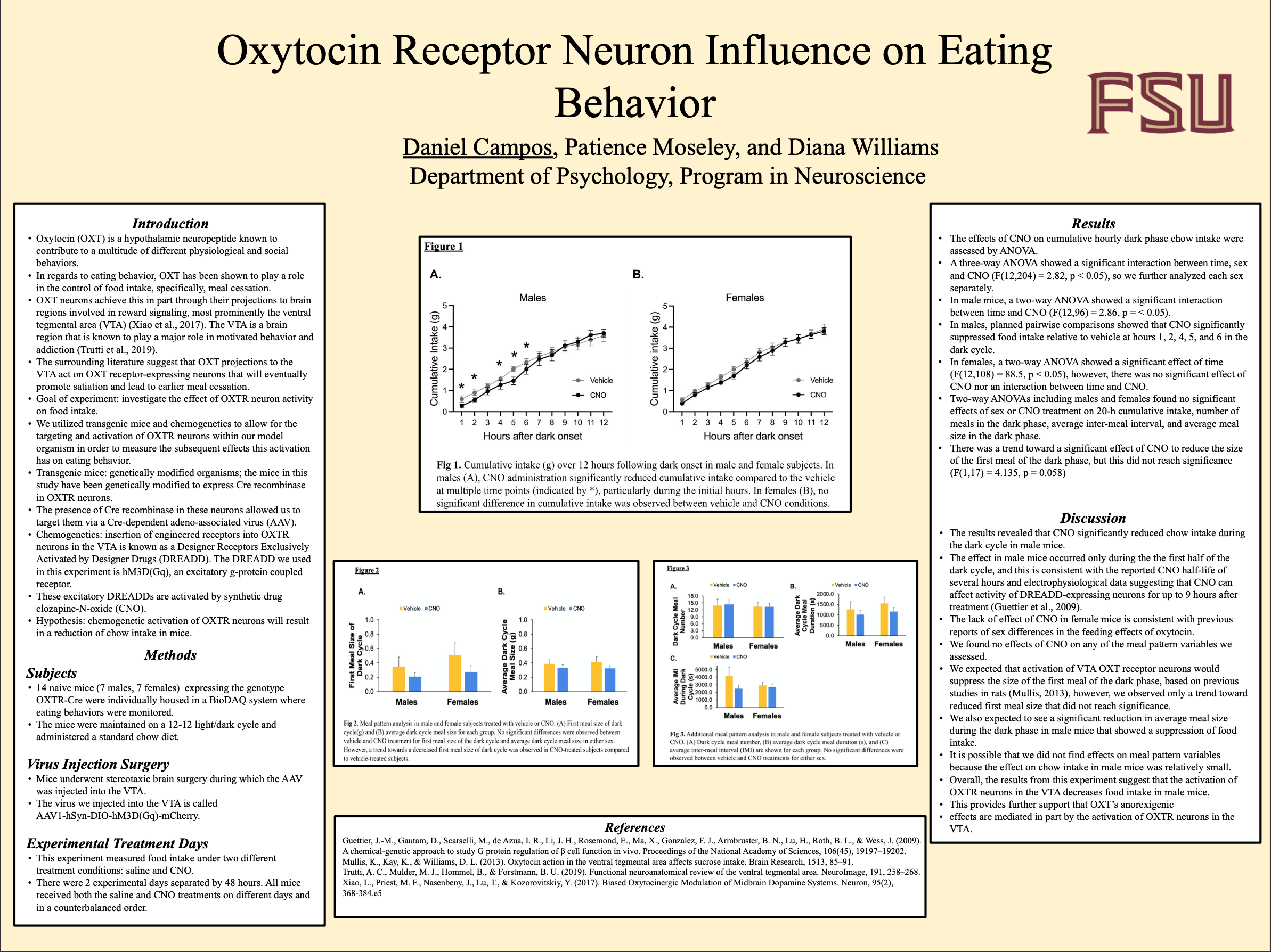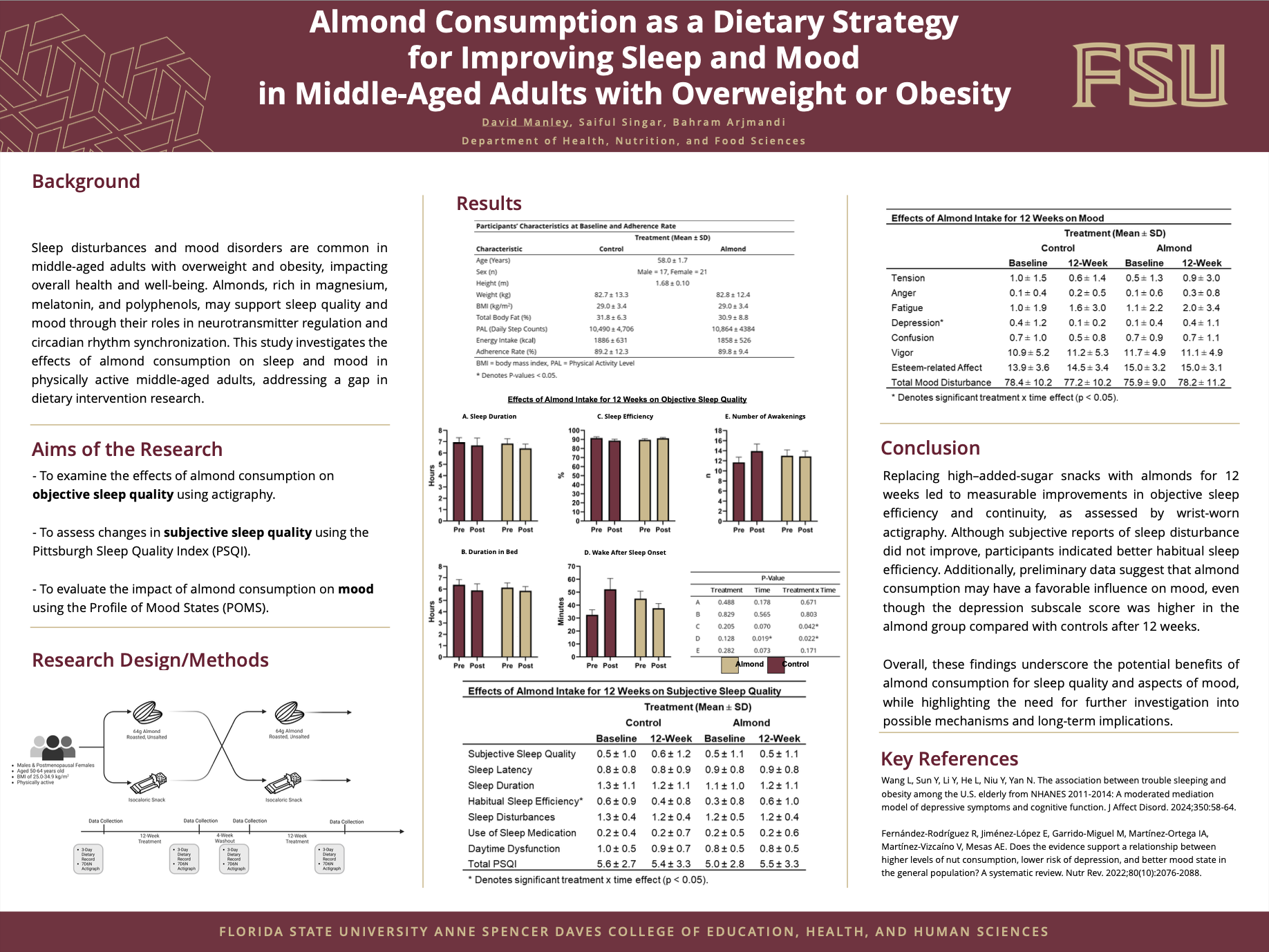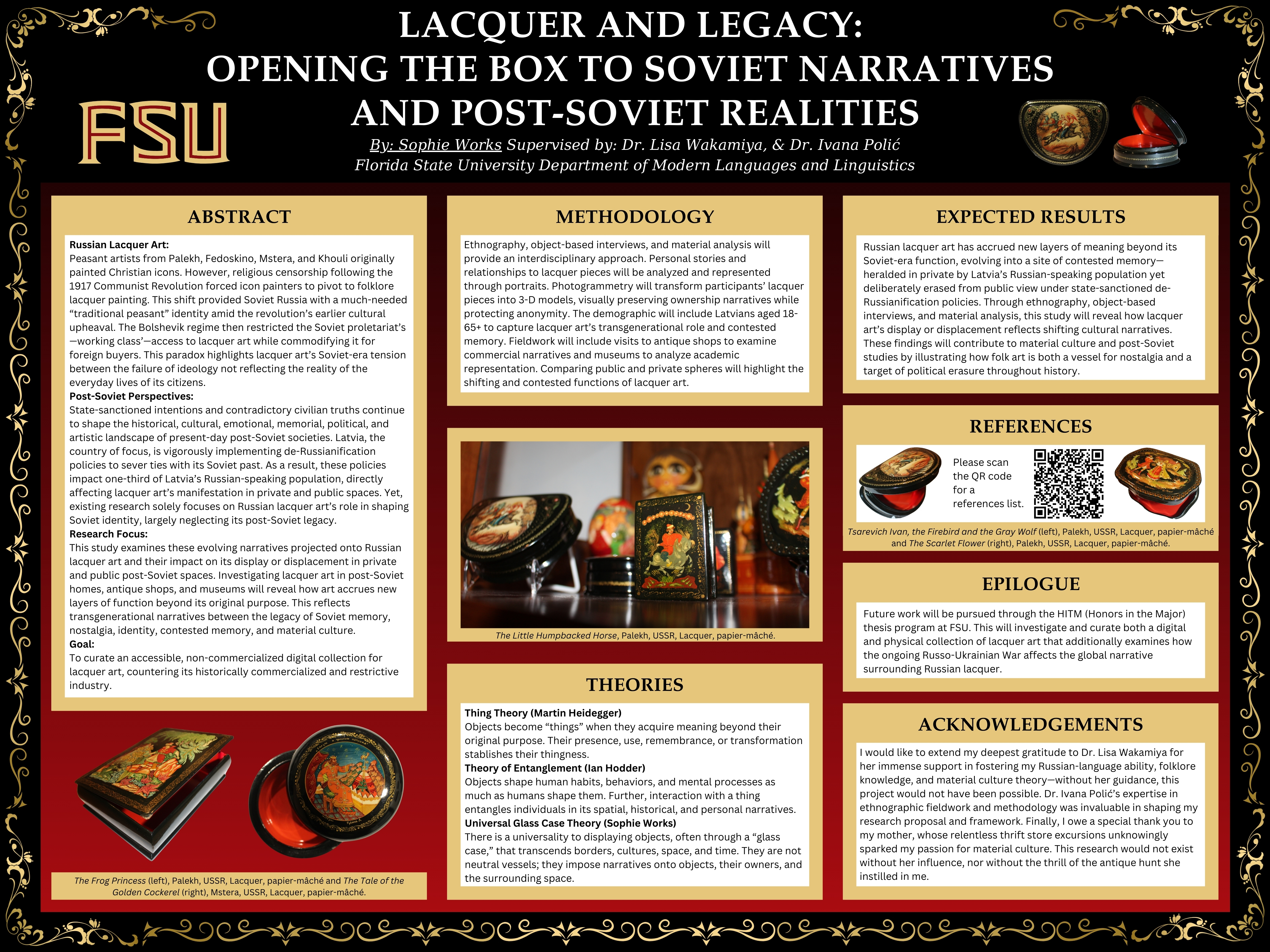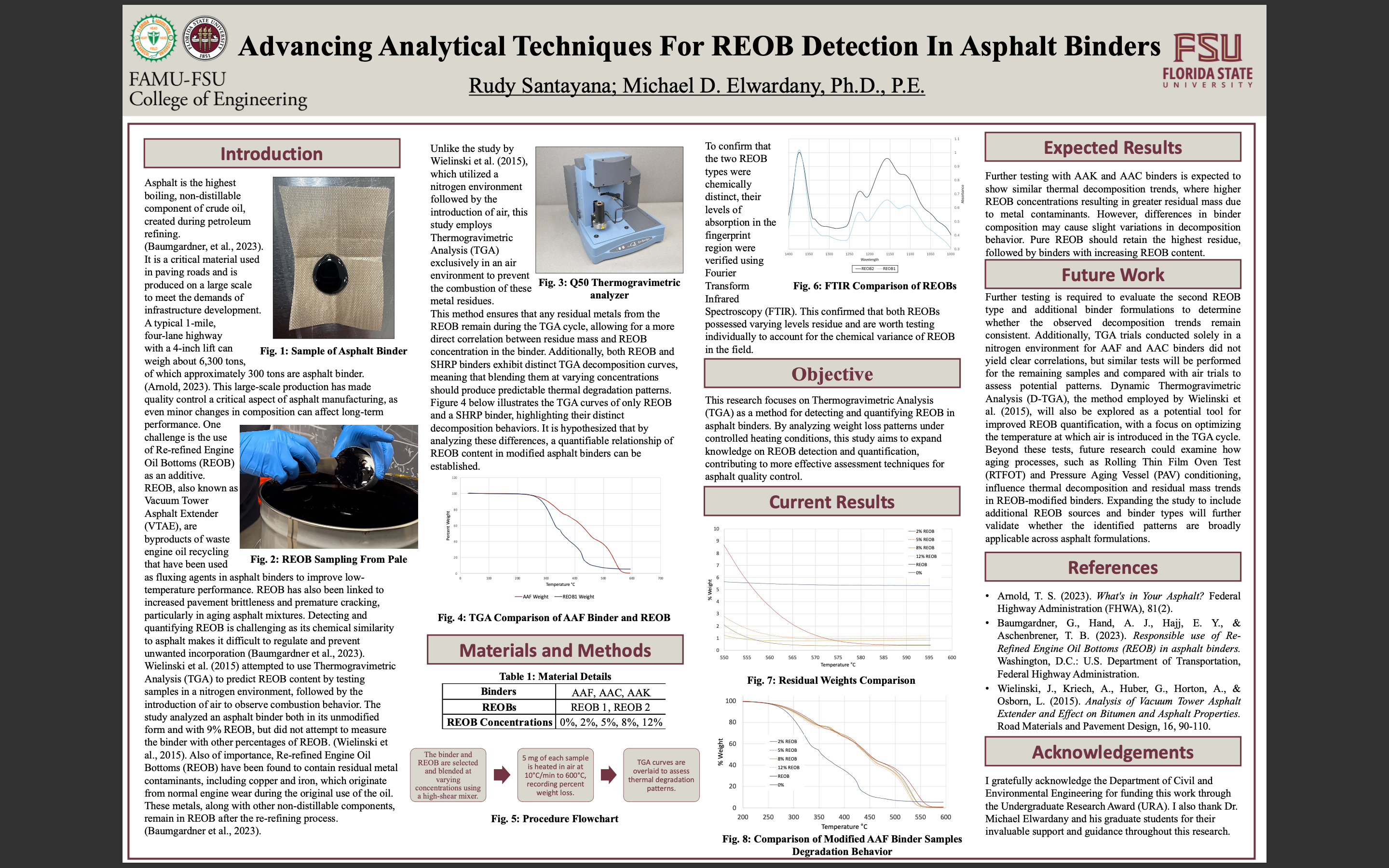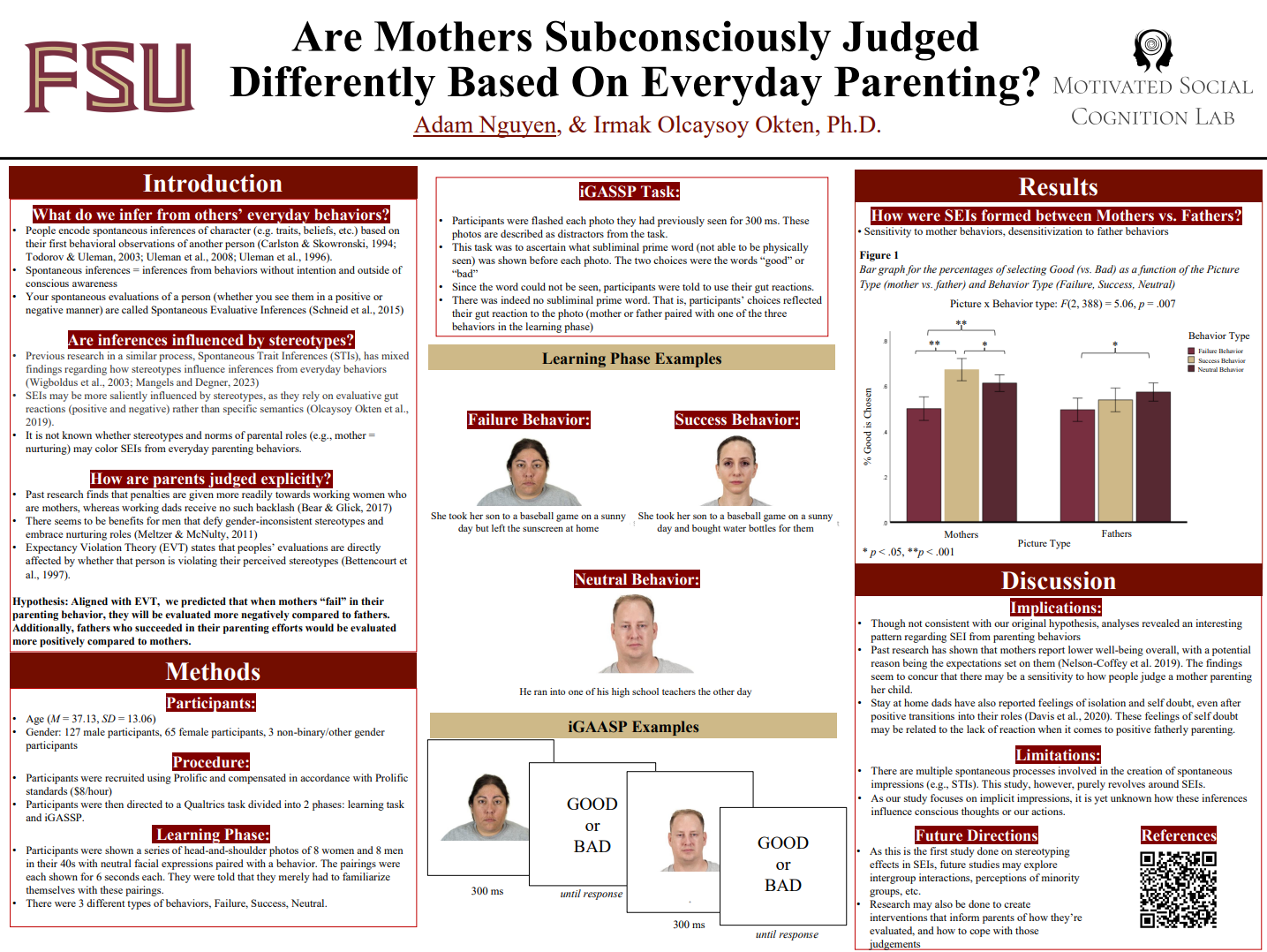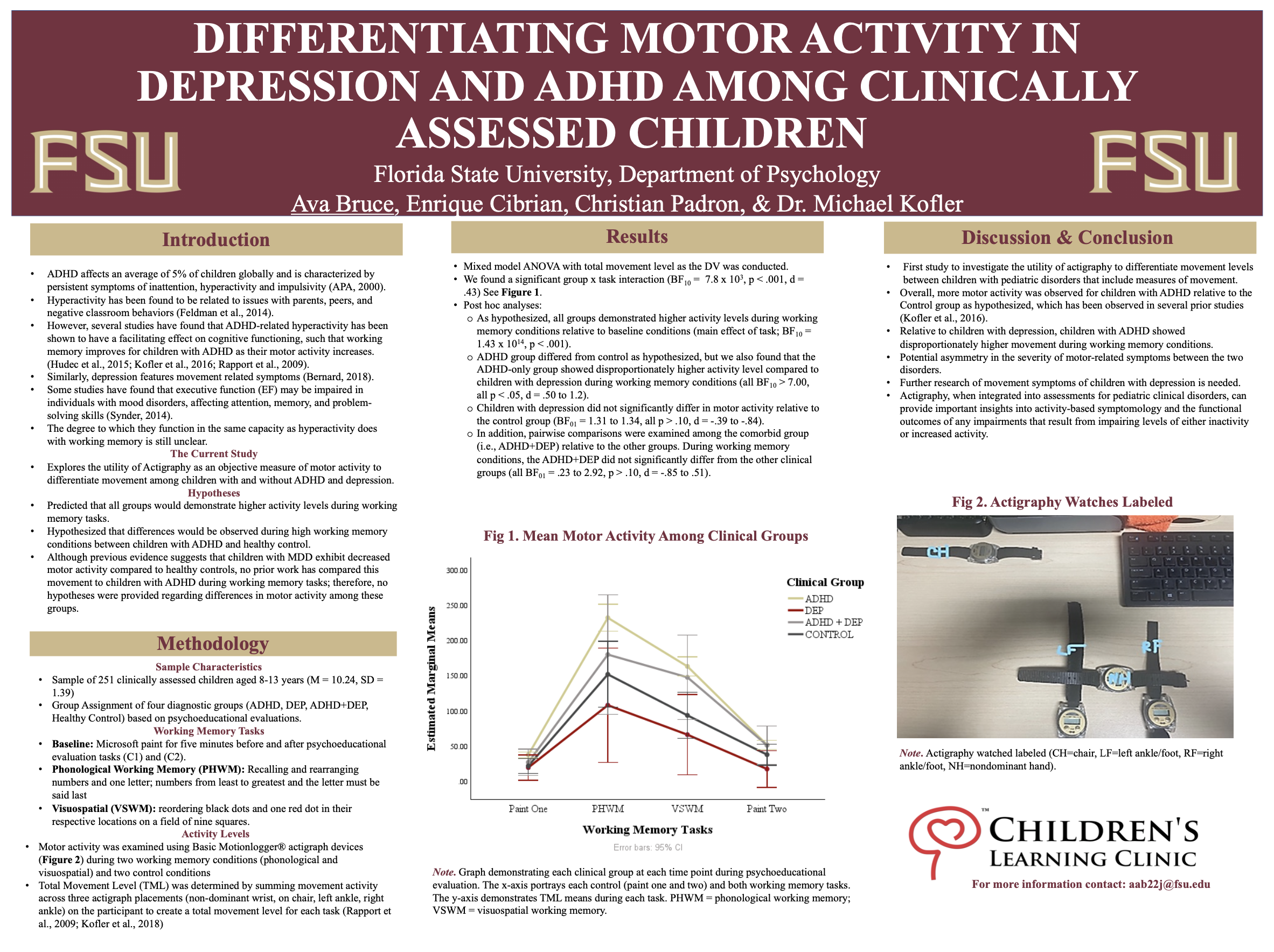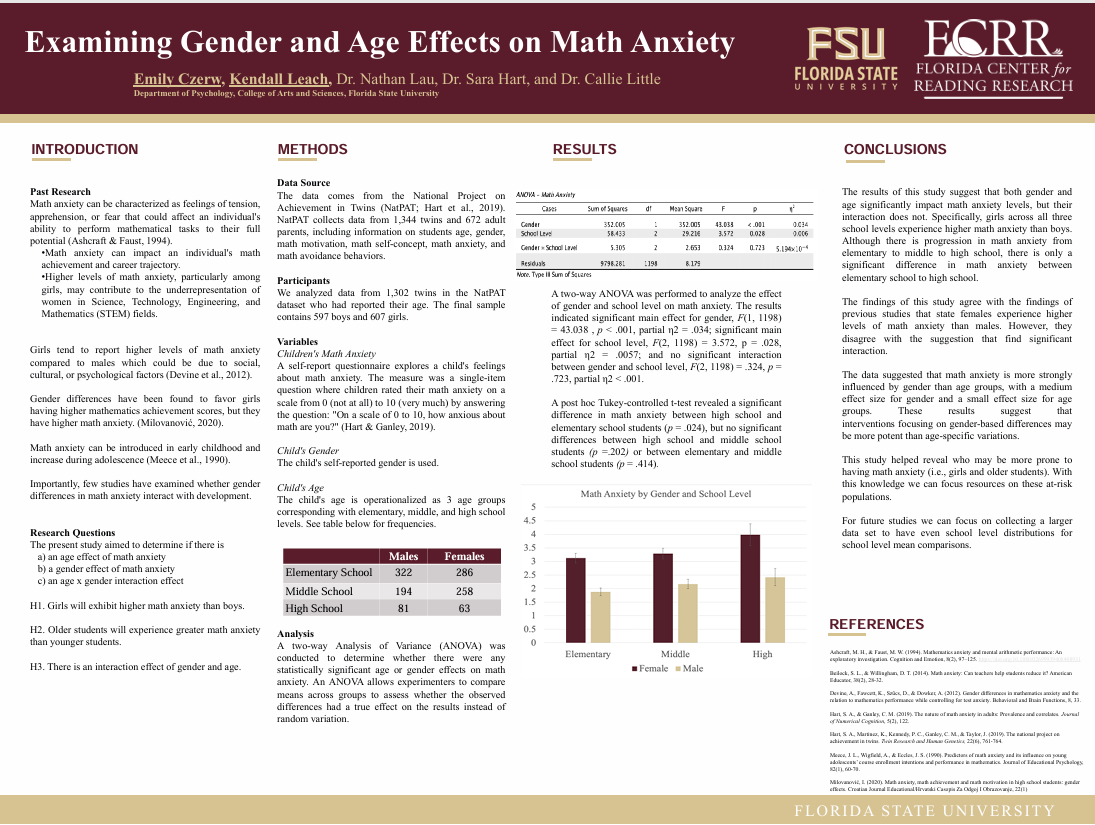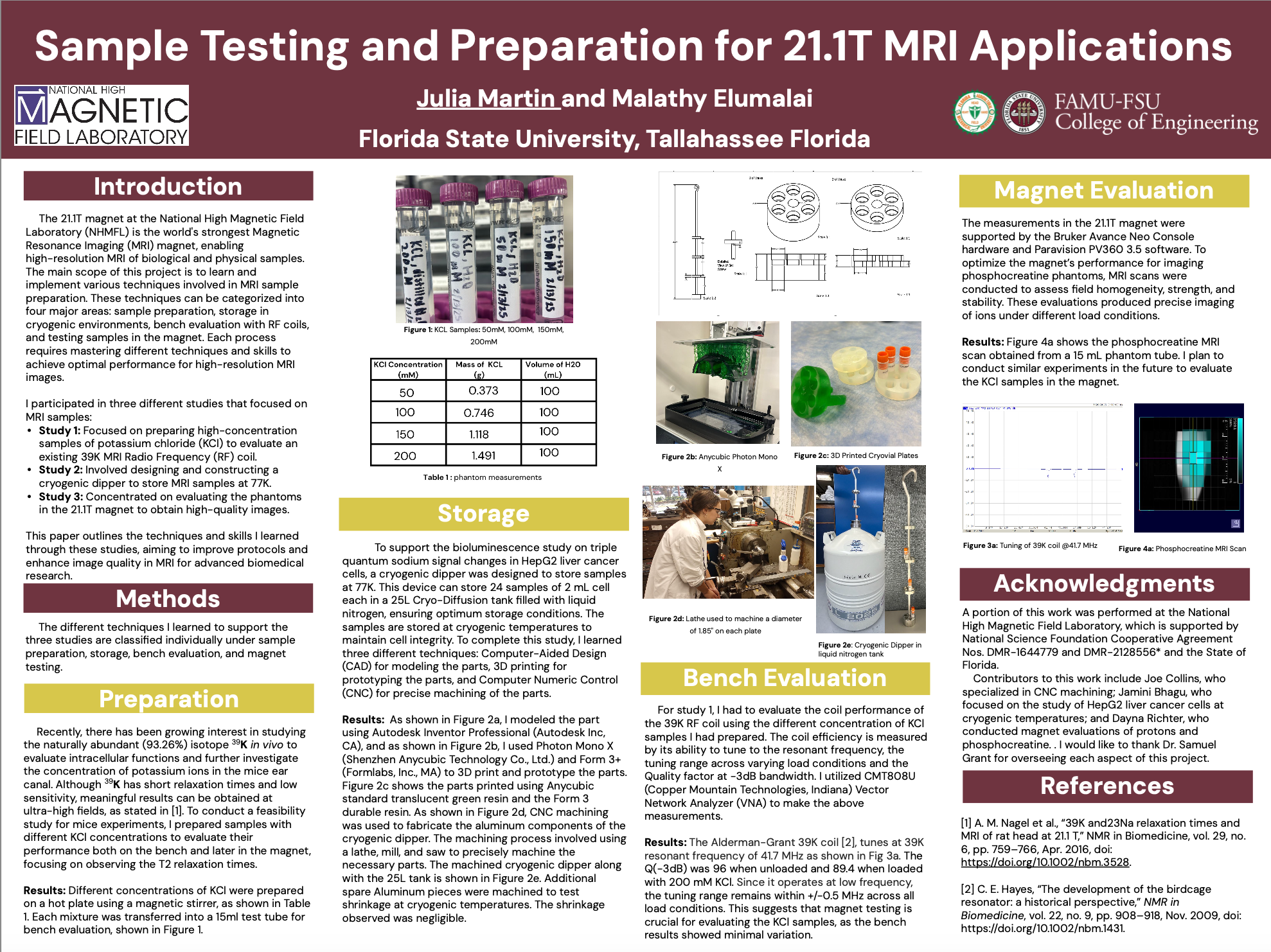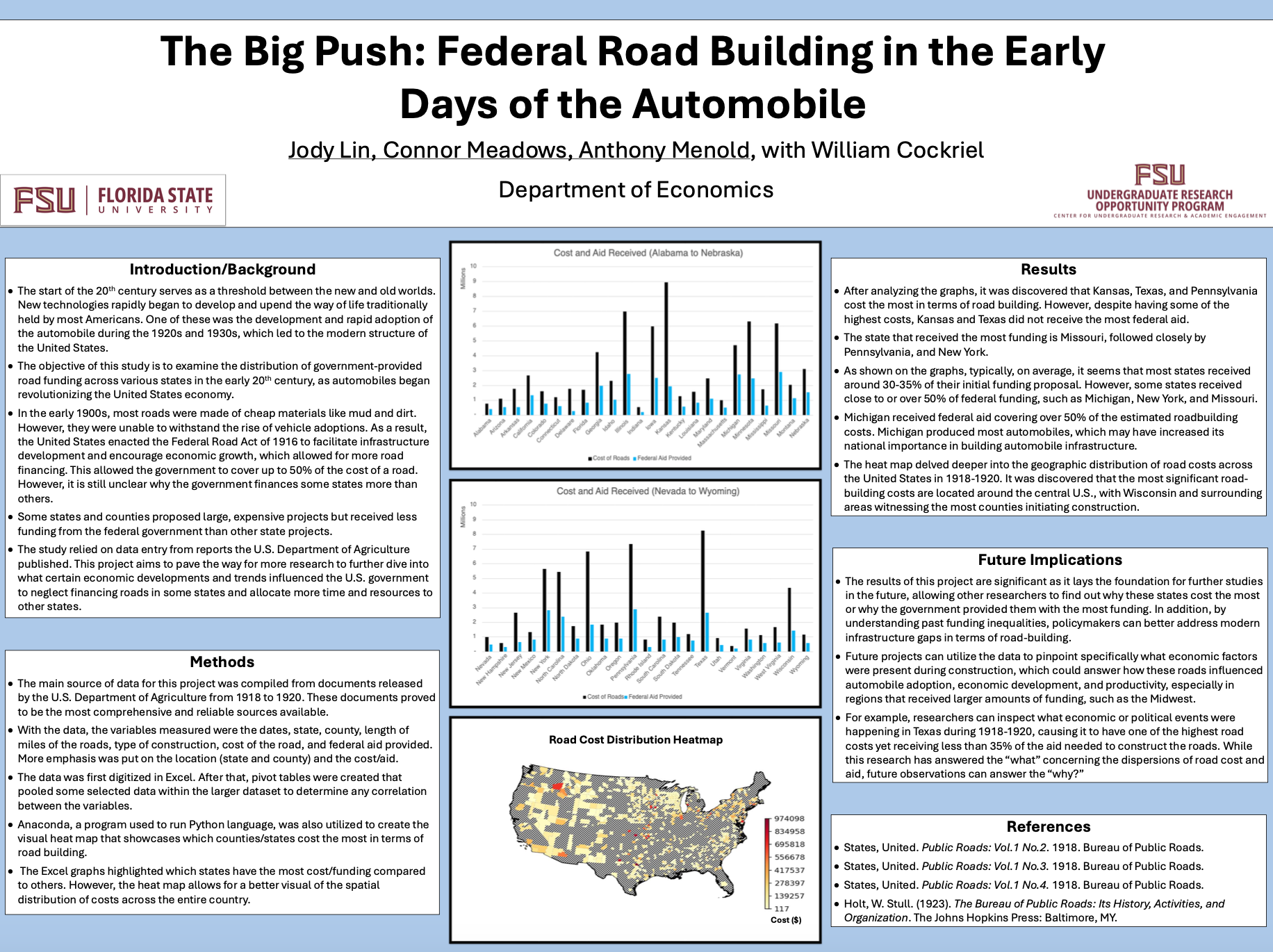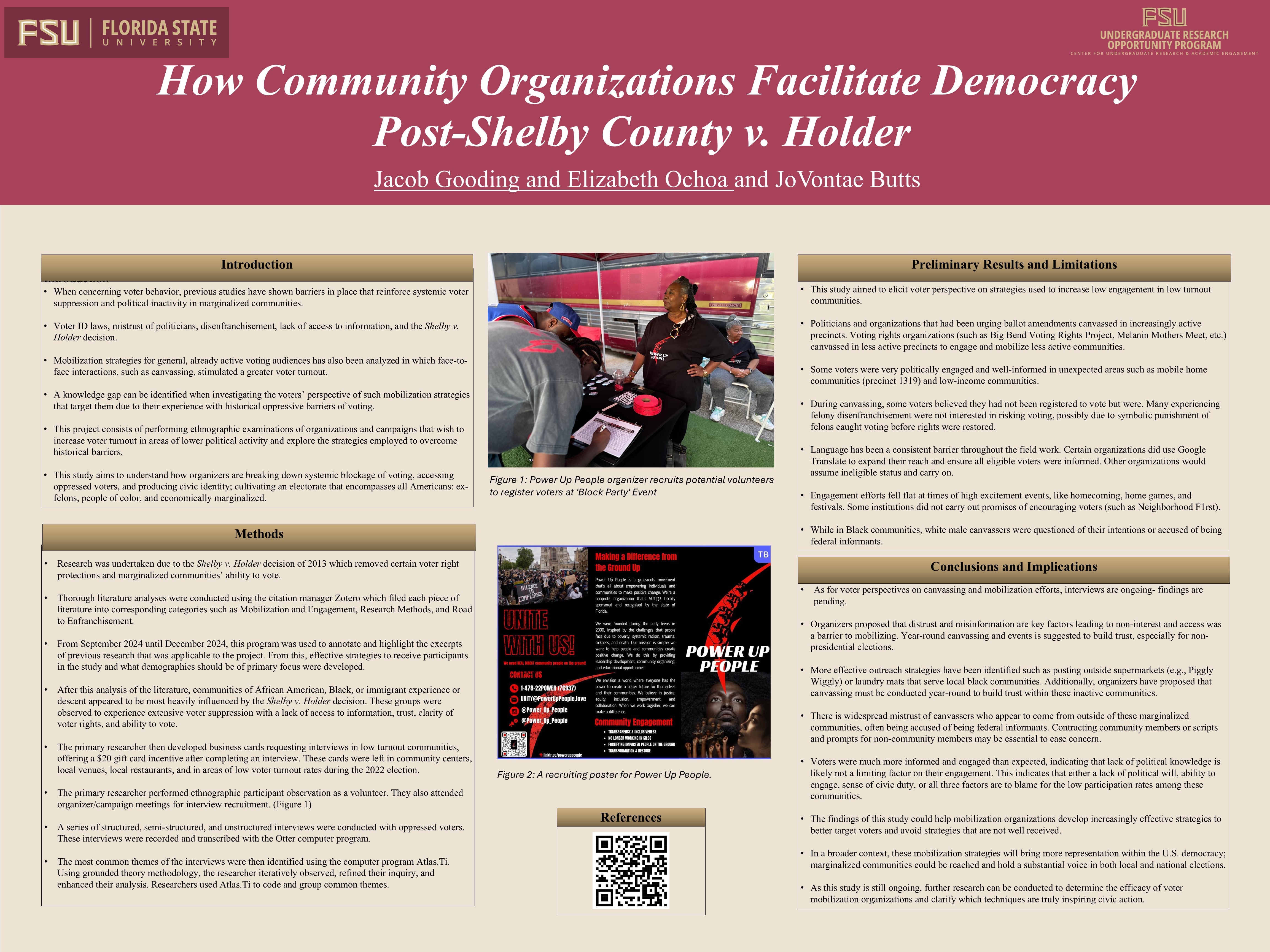Research Symposium
25th annual Undergraduate Research Symposium, April 1, 2025
Isabella Alamo Nourishing Creativity

BIO
Bella Lunel is a Latin-American painter and digital artist practicing in Tallahassee, FL. She is working on her undergraduate research thesis for Honors in the Major at Florida State University. Lunel’s research, titled Excess, Abjection, and Hypersexualization: Women in Horror, explores the dehumanizing nature in which women are represented and punished for their sexuality. The final product will feature a 12-page thesis and a solo exhibition of 6 paintings and 3 ceramic masks. Her work is heavily inspired by whimsical and gothic mythologies, as well as the tropes and structures of horror media. Lunel visually translates the dreamscape's surreal nature through a macabre aesthetic lens. Primarily working in large-scale oil painting, she is heavily inspired by the styles of the Renaissance and Romantic periods. Drawing her attention to the underrepresented female artists of these movements. Masters such as Artemisia Gentileschi and Elisabetta Sirani. With a dark color palette composed of deep violet, phthalo blues, and crimson, Lunel renders dream-like depictions of vaguely horrific scenarios. She leans into techniques such as chiaroscuro and sfumato, looking to portray a classical composition with a contemporary metaphor.
Excess, Abjection, Hypersexualization: Women In Horror
Authors: Isabella Alamo, Carrie Anne BaadeStudent Major: BA Art Studio
Mentor: Carrie Anne Baade
Mentor's Department: Art Department Mentor's College: Florida State University Co-Presenters:
Abstract
This thesis paper seeks to delve into the pervasive themes of excess, abjection, and the hypersexualization of the female form within the horror genre. Through painting and sculpture, this project examines the intentional use of excess violence, in particular with the portrayal of female figures as victims, to evoke emotional reactions from viewers. The structure of this paper provides a concise overview of the contemporary context and related research. Then it moves its focus into detailed research, materials, and aesthetic choices that mutually influenced one another throughout the project's development. Conclusively, this creative project aims to critically examine the treatment of women in horror, exploring the genre's historical and contemporary impact on societal perceptions of gender. The goal is to reflect the attitudes of the genre’s audience, confronting the apathetic and adverse reactions that arise when women are presented in pain that is directly attributed to their sexuality.
Keywords: horror, women, nudity
25th annual Undergraduate Research Symposium, April 1, 2025
Cameron Spencer Poster Session 4: 3:00 pm - 4:00 pm/ Poster #47
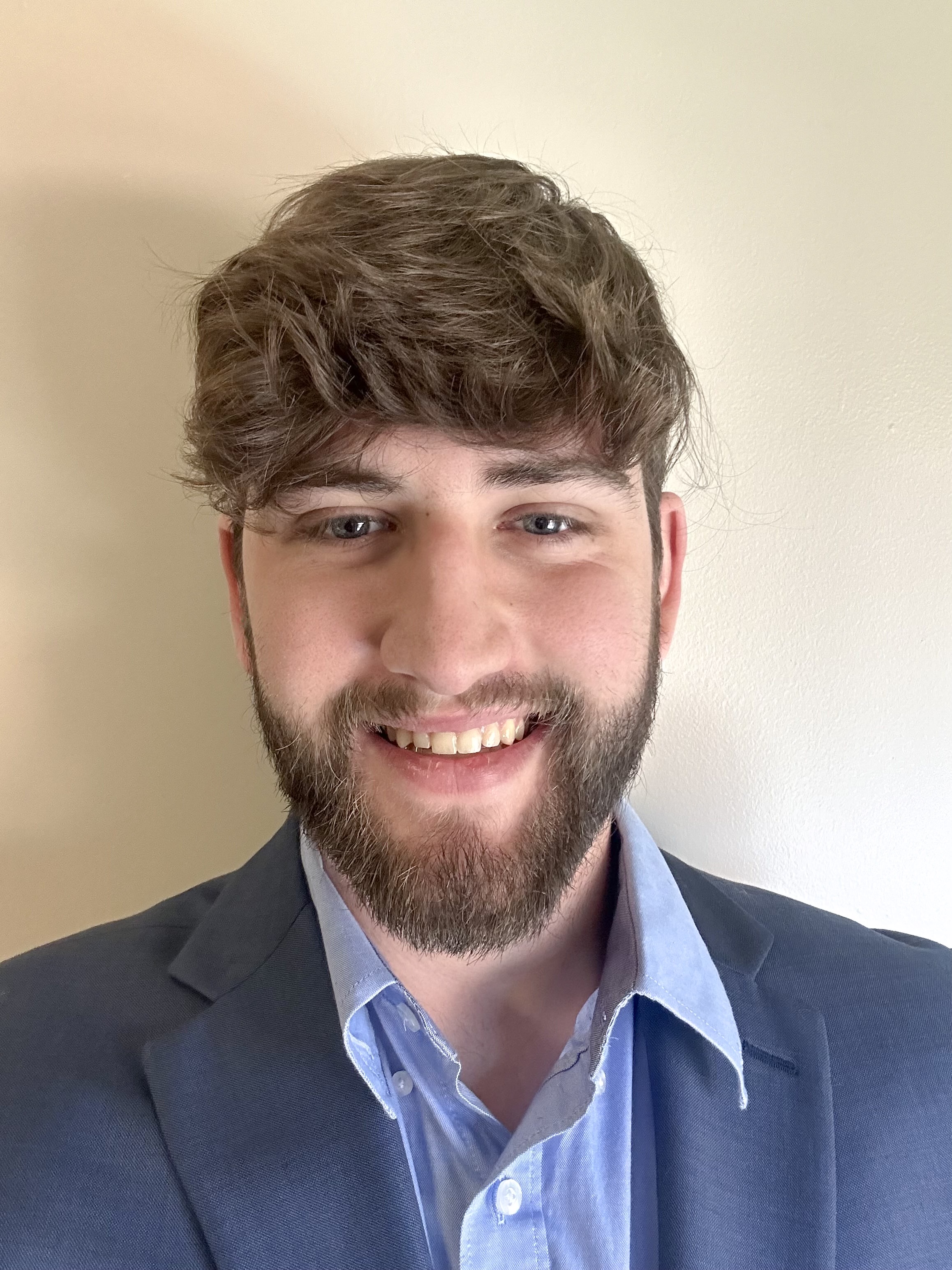
BIO
My name is Cameron Spencer, and I am a first year student at FSU. I am from Boynton Beach Florida and am currently studying Business Administration and Psychology. I am part of the FSU honors program, as well as UROP, and I am studying Art Education with my mentor Hung-Chi Chu. My personal research interests are in the field of Social Psychology, specifically focusing on parasocial relationships and their formation within young adults. However, my current research project, an exploration of Participatory Socially Engaged Art, has given me a new perspective on other kinds of research I may be interested in. I plan to continue working in this field and hope to develop a psychological approach to Aesthetic-Based Art Education. I hope to achieve a bachelors in both Business Administration and Psychology, eventually working to become a corporate consultant.
My name is Cameron Spencer, and I am a first year student at FSU. I am from Boynton Beach Florida and am currently studying Business Administration and Psychology. I am part of the FSU honors program, as well as UROP, and I am studying Art Education with
Authors: Cameron Spencer, Hung-Chi ChuStudent Major: Psychology and Business Administration
Mentor: Hung-Chi Chu
Mentor's Department: Department of Art Education Mentor's College: Collage of Fine Arts Co-Presenters:
Abstract
In our study my colleague and I aim to explore the merits of Participatory Socially Engaged Art (PSEA), specifically, its potential educational and social impacts. We explored other methods of education utilizing aesthetic theory, few of them include all the potential benefits PSEA offers. My colleague conducted field research, attempting to implement the system in a classroom. We also read literature on the subject to build a stronger understanding of PSEA as a whole. Our method of teaching has the potential to engage learners in a novel way. Within our paper we outline the theory used to justify our education style, and explore the modern application of aesthetic learning, specifically through PSEA. We analyzed a number of similar systems, as well as explained actual scenarios that have involved PSEA styles of education. Our data is mostly anecdotal, but my mentor organized it into a study exploring the optimal benefits of PSEA. We focused on Claire Bishop's balance of social factors with aesthetic value, and her exploration of secondary audiences to highlight the social importance/impact of our style. Our results showed that learning was to some degree improved by implementing PSEA. Students felt that they could be more active and involved in creating Social Art. The next step is collecting more data to support our theories and practices, by implementing this technique in classrooms, comparing it with classes not utilizing PSEA. Our study could change the way art education is taught, allowing projects to be more impactful and socially relevant.
Keywords: Participatory Socially Engaged Art,
25th annual Undergraduate Research Symposium, April 1, 2025
Sophia Solomon Poster Session 2: 10:45 am - 11:45 am/ Poster #253

BIO
My name is Sophia Solomon, and I am from Fort Lauderdale, Florida. I am a senior at FSU studying Public Health, Public Administration, and Emergency Management. My research interests include maternal and child health, health disparities, social determinants of health, and vaccine hesitancy. After graduation, I hope to gain a job in the administration of a non-profit health organization and earn my Master's of Health Science degree.
Undergraduate Honors Project: What I Learned About Vaccine Hesitancy in Florida’s Urban and Rural Communities
Authors: Sophia Solomon, Ladanya Ramirez Surmeier, PhDStudent Major: Public Health
Mentor: Ladanya Ramirez Surmeier, PhD
Mentor's Department: Public Health Mentor's College: Social Sciences and Public Policy Co-Presenters:
Abstract
Vaccinations are a critical tool in public health, yet disparities exist in vaccine uptake. In the recent COVID-19 pandemic, the necessary nature of getting vaccinated was devastatingly evident. Geographic location, particularly urban versus rural residency, may influence access and willingness to vaccinate. Understanding these differences can help guide targeted public health interventions. This study examines the relationship between geography and COVID-19 vaccination rates in Florida. It aims to determine whether urban or rural counties experience discrepancies in vaccination uptake, explore the factors contributing to these differences, and use literature to explain any differences. A quantitative analysis using logistic regression in SPSS and other exploratory data analysis methods compared vaccination rates between urban and rural counties in Florida. Data from 2021-2023 will be collected from the Census Bureau and the Florida Health Charts. A content analysis will complement the statistical findings, identifying key social determinants influencing vaccination rates. Peer-reviewed sources published since 2020 will be analyzed to uncover underlying themes and relationships. Preliminary findings suggest rural counties have lower COVID-19 vaccination rates than urban counties. Other significant variables that coincide with rural counties are income, education, and political affiliation. Geographic classification acts as a proxy for social determinants of health such as healthcare access, education, and transportation. These upstream factors likely contribute to the observed disparities. Understanding geographic disparities in vaccination rates is crucial for designing equitable public health interventions. Findings will inform targeted strategies to improve vaccine access and uptake in rural areas.
Keywords: Vaccine, COVID-19, Rural
25th annual Undergraduate Research Symposium, April 1, 2025
Ishaa Khosla Poster Session 3: 1:45 pm - 2:45 pm/ Poster #78
BIO
I'm an undergraduate psychology major with a genuine passion for neuroscience and cognitive research. My current work explores memory processes, specifically using non-invasive brain stimulation and eye-tracking to investigate false memory formation. Beyond my research, I'm deeply interested in the intersection of memory and mental health. I am passionate about bridging the gap between scientific research and public understanding, using my background in psychology and commitment to public health to make complex findings accessible. My career vision combines psychological research, public health advocacy work, and narrative journalism to create opportunities to amplify diverse perspectives that have otherwise been overlooked. II believe that data-driven research and compassionate journalism can work together to transform how we understand and address mental health challenges in our society.
Tracking The Unseen: Implicit factors that shape False Memory formation
Authors: Ishaa Khosla, Marissa A. MunroeStudent Major: Psychology
Mentor: Marissa A. Munroe
Mentor's Department: Department of Psychology Mentor's College: College of Arts and Sciences Co-Presenters: Ellie Mordujovich
Abstract
False memory is defined as the distortion of certain events leading to a false recollection of memory. This research study aims to investigate implicit factors that may influence the encoding and retrieval of false memories. Additionally, it will explore how non-invasive brain stimulation can modulate false memory formation and recall. We are examining implicit factors such as demographic influences and pupil dilation measured through eye tracking. Within demographic research proposes a theory known as ‘own-race bias’ explaining that those who identify most with the people in stimuli will more accurately identify people of their own race compared to other-races. Research has shown that pupil dilation can be a potential identifier between false and correct memories. In this study, we will use noninvasive brain stimulation—transcranial magnetic stimulation (TMS)—to modulate the hippocampal-cortical network (HCN), a key system involved in memory encoding and consolidation. Our task includes a naturalistic stimuli phase (a video) and a test phase (multiple choice, audio, visual questions). TMS will be delivered at the left parietal cortex – which indirectly increases the HCN – pre-video, post-video, pre-test, or none to potentially increase accuracy with questions.We hypothesize that TMS will diminish own-race bias and increase recall accuracy. Prior to running the full study we conducted a pilot study which tested the difficulty of the questions we will use in our simulation-based study. Results from this study will increase our understanding of false memory and provide insight as to how implicit factors play a role in the encoding of those memories.
Keywords: Memory, Transcranial Magnetic Stimulation, Eye-tracking, False Memory, fMRI
25th annual Undergraduate Research Symposium, April 1, 2025
Emma LaBonte Poster Session 1: 9:30 am - 10:30 am/ Poster #102

BIO
I am a Neuroscience major from Tampa, Florida. I love doing research and have spent the last year studying climate reconstruction from coral fossils in the Atwood Lab at FSU. I hope to study neurological disorders in the future!
Testing Pavona spp. Corals for Paleoclimate Reconstruction Isla Pinzon, The Galápagos Islands, Ecuador
Authors: Emma LaBonte, Neda MobasherStudent Major: Neuroscience
Mentor: Neda Mobasher
Mentor's Department: EOAS Mentor's College: College of Arts and Sciences Co-Presenters:
Abstract
Scleractinian (“stony”) corals are valuable archives that track past SST variability before direct measurements were available through variations in the geochemical composition of their aragonite skeletons. In the Galápagos Islands, Porites corals have been used to track long-term variations in the El Niño-Southern Oscillation (ENSO) because they are long-lived, slow-growing, and have clear seasonal banding patterns. At the Galápagos Islands, the Equatorial Undercurrent (EUC) shoals cause a massive upwelling of cold water to the surface ocean. Additionally, trade winds along the equator significantly affect the strength of the surface currents in this region, making conditions in the Galapagos significantly colder than in other parts of the tropical Pacific.
These oceanographic conditions make Porites highly sensitive to changes in ENSO variability, causing significant stress and mortality on corals in the Galapagos Islands. Pavona corals are similarly sensitive in the Galápagos but have not been as thoroughly researched in recording past climate variability. For this project, two Pavona clavus corals collected from the living reef in the 20th century were provided by Dr. Ellen Druffel at the University of California – Irvine to develop paleoclimate reconstructions of the 20th century. The corals, collected from Urbina Bay (0.988° S, 91.420° W) in 1954 and Isla Pinzon (0.609°S, 90.723°W) in 1977 are being analyzed for d18O, Sr/Ca, and U/Ca. These reconstructions are contributing to a spatial reconstruction of ENSO variability in the Galápagos Islands and will help determine if Pavona is a viable genus to develop climate reconstructions to include multiple genera.
Keywords: Corals, Fossils, Climate, Ocean
25th annual Undergraduate Research Symposium, April 1, 2025
Charu Gopal Poster Session 2: 10:45 am - 11:45 am/ Poster #77
BIO
Hi, my name is Charu Gopal. I am a senior at Florida State University pursuing a B.S. in Economics with minors in Statistics and Business. My experience in finance and energy markets through past internships shaped my analytical skills, but my genuine interest lies in behavioral economics and econometrics. In fall 2024, I joined the DeVoe L. Moore Center as a public policy intern to deepen my understanding of economic research and policy analysis. Looking ahead, I aim to expand my research experience in graduate school, focusing on data-driven insights to address complex economic challenges.
Quantitative Research Techniques For New Policy Researchers: Examples from Housing and Crime Literature
Authors: Charu Gopal , Crystal TaylorStudent Major: Economics
Mentor: Crystal Taylor
Mentor's Department: Urban & Regional Planning department Mentor's College: College of Social Sciences and Public Policy Co-Presenters:
Abstract
Homeownership is widely associated with lower crime rates compared to renting, as homeowner-dominated communities tend to foster stronger social ties and crime prevention. However, the homeownership-crime relationship is not always straightforward even for researchers. Factors such as transient populations (e.g., college students), different geographical locations, neighborhood resources, socio-economic dynamics, and the local policy landscape can disrupt neighborhood effects. Based on recent literature, what are the methodological best practices to explore the relationship between homeownership and crime? An in-depth review of literature was conducted using library and online databases JSTOR, Google Scholar, FSU Libraries on leading economics, housing, sociology, criminal justice, and methodological journals spanning the past thirty years. The research used the following search terms homeownership, crime, neighborhood, relationship, empirical analysis for this review. For highly cited papers, reference lists were reviewed. Preliminary results reveal four main methodological techniques used for housing and crime research: (A) a cross-sectional multivariate linear regression to help address reverse causality, where crime may deter homeownership decisions; (B) a two-stage least squares regression to isolate exogenous variation in homeownership through an instrument; (C) a difference-in-differences estimation to compare policy impact under the parallel trends assumption; and (D) a two-wave cross-lag model to analyze the reciprocal relationship between homeownership and crime. These methodologies contribute to ongoing debates on the role of homeownership in crime prevention and offer practical insights for future researchers.
Keywords: Homeownership, Crime, Relationship, Empirical Analysis
25th annual Undergraduate Research Symposium, April 1, 2025
Malena Edu Poster Session 4: 3:00 pm - 4:00 pm/ Poster #148

BIO
Malena Edu is a first-year student from Jacksonville, Florida, studying Human Development and Family Sciences on a pre-physician assistant (PA) track. Through her studies, she has explored human development across the lifespan and developed a particular interest in pediatric and older adult populations. At FSU, she is actively involved in the Pre-Physician Assistant Club and the undergraduate chapter of the American Medical Women's Association (AMWA). Passionate about service, she engages in various volunteer efforts and is committed to becoming a healthcare provider who advocates for equity and accessibility in medicine.
The Relationship Between ICT Use and Age-Related Cognitive Decline in Older Adults: A Longitudinal Meta-Analysis
Authors: Malena Edu, Dr. Dorota Kossowska-KuhnStudent Major: Human Development and Family Sciences
Mentor: Dr. Dorota Kossowska-Kuhn
Mentor's Department: Department of Psychology Mentor's College: College of Arts and Sciences Co-Presenters: David Angarita
Abstract
As the global population ages, maintaining cognitive health has become increasingly important. This study investigates the link between information communication technology (ICT) use and age-related cognitive decline among older adults aged 50 and above at baseline. Although some preliminary research suggests that utilizing ICT may improve cognitive function, no clear consensus exists. In particular, little is currently known about the effects of ICT use on cognition over time. In this study, we aimed to explore the effects of this relationship by conducting a meta-analysis of longitudinal studies where ICT use and cognitive function were assessed repeatedly over an extended period. We systematically reviewed existing literature in this domain using Covidence software to perform title and abstract screening, full-text screening, and data extraction. Although our analysis is still ongoing, preliminary results indicate that ICT use may be associated with improved cognitive function in older adults. Further research is necessary, but these results may eventually lead to discoveries of whether ICT could be used interventionally to slow or prevent cognitive declines in this age demographic. As technology becomes increasingly embedded into daily life, understanding its effects on aging and brain health could lead to significant implications for public health and future generations.
Keywords: Technology, ICT, Cognitive Decline, Psychology, Aging
25th annual Undergraduate Research Symposium, April 1, 2025
Daniel Campos Poster Session 2: 10:45 am - 11:45 am/ Poster #97

BIO
Daniel was born and raised in Miami, Florida. Graduating in 2025 with a degree in Behavioral Neuroscience, his career goals include obtaining an MD degree in order to pursue a career as a clinician and medical scientist.
Oxytocin Receptor Neuron Influence on Eating Behavior
Authors: Daniel Campos, Diana WilliamsStudent Major: Behavioral Neuroscience
Mentor: Diana Williams
Mentor's Department: Neuroscience Mentor's College: Psychology Co-Presenters:
Abstract
An issue we face in western countries pertains to pathologies caused by a dysregulation of food intake. Research on the neurobiology that mediates eating behavior is essential for developing effective treatments for these pathologies. Oxytocin (OXT) is a hypothalamic neuropeptide most well known for its role in social and reproductive behaviors. OXT neurons also affect eating behavior via projections to several areas of the brain including the ventral tegmental area (VTA), which is most well known for its role in reward. This study investigates the role of oxytocin receptor (OXTR)-expressing neurons in the VTA in eating behavior in mice using chemogenetics. Mice expressing Cre recombinase in OXTR neurons received virally-mediated gene therapy to induce an excitatory Designer Receptor Exclusively Activated by Designer Drugs (DREADD) in VTA OXTR neurons. When activated by the drug clozapine-N-oxide (CNO), these receptors depolarize the neurons. We examined the food intake effects of this OXTR neuron activation compared with vehicle treatment. Results revealed that the activation of VTA OXTR neurons significantly suppressed chow intake in male mice but not in females, consistent with previously observed sex differences in oxytocin-mediated eating behaviors. This study provides support for the role of OXTR neurons in the VTA in the modulation of eating behaviors and therefore may provide insight into the biological mechanism that mediates OXT’s reduction in eating behavior. Further research into understanding the neural circuitry that mediates OXT’s effects could potentially lead to the development of pharmacological treatments for pathological eating behaviors.
Keywords: Oxytocin, neurons, receptors, eating, neuroscience
25th annual Undergraduate Research Symposium, April 1, 2025
Morgan Brown Poster Session 1: 9:30 am - 10:30 am/ Poster #160
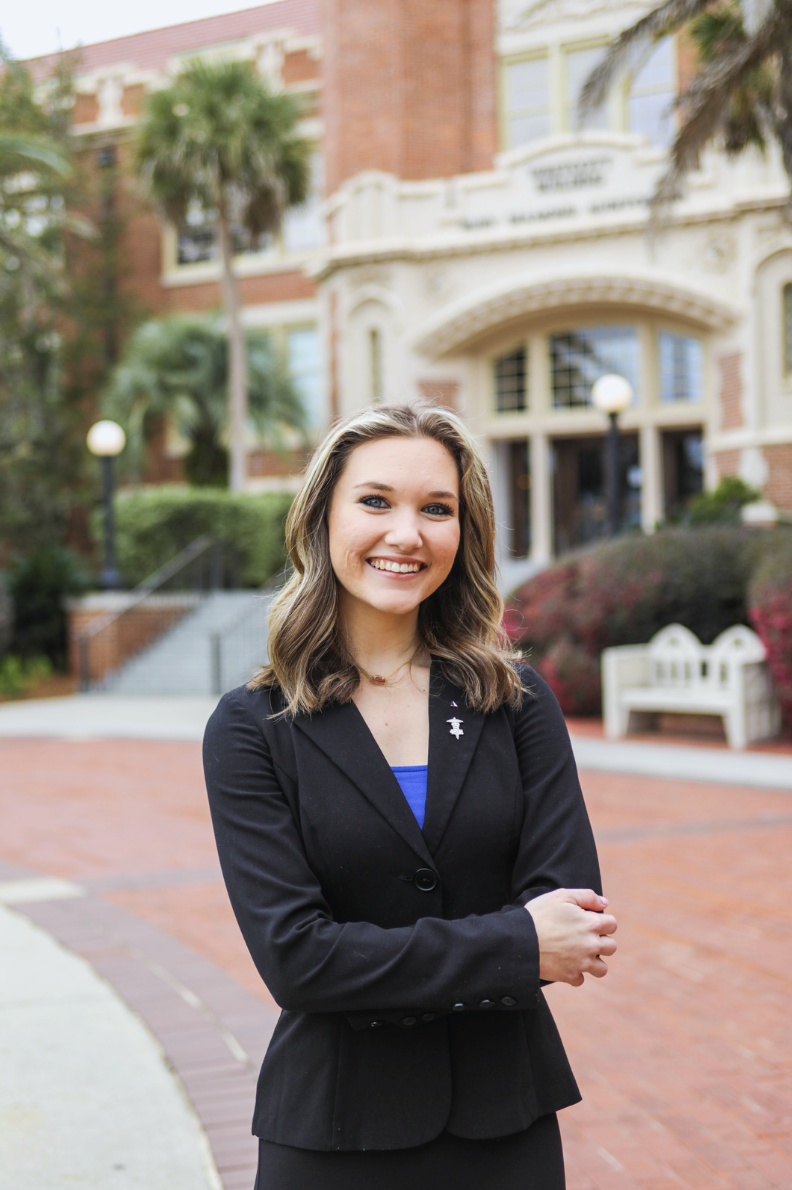
BIO
My name is Morgan Brown, and I’m originally from Boca Raton, Florida. I’m currently majoring in Behavioral Neuroscience with a strong interest in internalizing disorders, particularly depression and trauma-related conditions. My academic focus centers on using neuroimaging techniques to explore the complex neural mechanisms that underlie psychiatric disorders and how novel treatment paradigms, such as Transcranial Magnetic Stimulation (TMS), can support and enhance psychotherapies.
Over the past year, I’ve had the opportunity to work as a research supervisor studying facets of cognitive control and how non-invasive brain stimulation influences cognitive performance. This experience has not only solidified my future career goals but also broadened my perspective on the intricate interplay between various neural regions and higher-order cognitive functions.
Moving forward, I’m committed to continuing both my research within the psychology department and my clinical involvement at Tallahassee Memorial Hospital. These dual experiences have shaped my long-term goal: to pursue a PhD in Clinical Neuroscience. I hope to contribute to advancing our scientific understanding of psychiatric conditions while also applying that knowledge to support compassionate, evidence-based care.
Investigating the neural basis of cognitive control using delta and theta Transcranial Magnetic Stimulation
Authors: Morgan Brown, Justin RiddleStudent Major: Behavioral Neuroscience
Mentor: Justin Riddle
Mentor's Department: Psychology Mentor's College: Arts and Sciences Co-Presenters:
Abstract
Hierarchical cognitive control involves managing multiple layers of rules and goals, enabling us to flexibly switch between and nest these rules to guide context-appropriate behavior. Distinct neural mechanisms have been identified in this process, particularly in the prefrontal cortex. Prior research has established that delta oscillatory activity is often implicated in rule abstraction, whereas theta oscillatory activity is associated with set size - both of which are key components of hierarchical cognitive control. Given these findings, the present study seeks to examine the behavioral effects of modulating these distinct oscillatory dynamics through transcranial magnetic stimulation (TMS), a safe, non-invasive brain stimulation tool. Among a sample of young adult participants, we expect that delta frequency stimulation will enhance performance regarding rule abstraction while theta frequency stimulation will improve behavioral metrics related to set-size management. Our future aims are to analyze neurophysiological data collected with high-density EEG to assess the causal role of delta and theta oscillations in underlying hierarchical cognitive control.
Keywords: Transcranial magnetic stimulation, EEG, cognitive control, oscillations, neuroscience
25th annual Undergraduate Research Symposium, April 1, 2025
David Manley Poster Session 2: 10:45 am - 11:45 am/ Poster #101
BIO
My career goal is to become a physician with my current interests being in orthopedic surgery and neurology. Some research topics I am interested in are how diet and exercise can improve different health markers. Current Research involvements are in the Almond and Watermelon studies with The Gut Biome Lab under the Annes College of Education, Health, and Human Sciences. In the future, I would like to investigate the psychology behind fitness and how to progress the U.S. in becoming more active and consuming healthier diets.
Almond Consumption as a Dietary Strategy for Improving Sleep and Mood in Middle-Aged Adults with Overweight or Obesity
Authors: David Manley, Bahram ArjmandiStudent Major: Exercise Physiology
Mentor: Bahram Arjmandi
Mentor's Department: Health, Nutrition, and Food Sciences Mentor's College: Anne's College of Education, Health, and Human Sciences Co-Presenters:
Abstract
Objectives: This study examined the effects of almond intake, rich in magnesium and tryptophan, on objective and subjective sleep measures and mood in middle-aged adults with overweight or obesity.
Methods: A crossover RCT included 17 males and 21 postmenopausal females aged 50–64 with a BMI of 25.0–34.9 kg/m². Participants consumed 64g of almonds or an isocaloric control snack daily for 12 weeks, separated by a 4-week washout. At baseline and post-intervention, sleep measures and mood were assessed via actigraphy, the Pittsburgh Sleep Quality Index, and the Profile of Mood States. Linear mixed model analyses were conducted to determine the main (treatment and time) and interaction effects. A p-value of 0.05 was considered statistically significant.
Results: There was a significant Treatment×Time interaction for sleep efficiency (b=7.0%, p=0.043), with the almond group exhibiting greater improvements from baseline to 12 weeks compared to controls. In addition, there was a significant main effect of Time on wake after sleep onset (WASO) (b=25min, p = 0.047), indicating an overall increase in WASO over the study period. This main effect was further qualified by a significant Treatment×Time interaction (b=–36min, p = 0.043), such that the almond group demonstrated a more favorable trajectory in WASO changes relative to the control group. Almond intake did not significantly affect subjective sleep measures and mood (all p>0.05).
Conclusions: Almond intake improved sleep efficiency and reduced wake after sleep onset in middle-aged adults with overweight or obesity but had no significant effects on perceived sleep quality or mood.
Keywords: Almond, Sleep, Obesity
25th annual Undergraduate Research Symposium, April 1, 2025
WESLEY BAUM Poster Session 4: 3:00 pm - 4:00 pm/ Poster #206

BIO
I'm Wesley Baum, a freshman Entrepreneurship student and FSU Presidential Scholar from Brooksville, Florida. I work remotely as an AI Automation Engineer at Bluleadz, a HubSpot solutions partner, where I develop custom AI agentic solutions for both internal use and enterprise clients. For my UROP project with Dr. Suslov at the National High Magnetic Field Laboratory, I'm building an automated system that extracts data from scientific papers about cryogenic amplifiers. I'm looking forward to continuing to explore applications of AI technology throughout my time at FSU.
Automated Technical Information Extraction from Scientific Literature Using Artificial Intelligence
Authors: WESLEY BAUM, Alexey SuslovStudent Major: Entrepreneurship
Mentor: Alexey Suslov
Mentor's Department: National High Magnetic Field Laboratory Mentor's College: National High Magnetic Field Laboratory Co-Presenters:
Abstract
Efficient extraction of specific technical information from scientific literature remains a significant challenge for researchers across disciplines. This project develops an automated literature analysis system using Large Language Models (LLMs) to identify and extract targeted information from research papers. We are implementing this system through n8n, an open-source JavaScript-based automation platform running on a Digital Ocean droplet, customized JavaScript for data manipulation, the OpenAI API, and Google Sheets API, with our initial application focusing on identifying transistor model information from studies performed at cryogenic temperatures to assess the commercial availability of these transistors. The system employs custom prompting strategies to optimize accurate extraction while maintaining flexibility for adaptation to other research domains. Preliminary testing demonstrates successful automated identification of specific technical components from papers, with the modular architecture allowing for straightforward retargeting to different types of technical data extraction. This scalable approach to scientific literature analysis has incredible implications beyond our initial use case, as it could potentially accelerate the often lengthy and tedious literature analysis across various fields requiring large-scale quantitative data by automating the extraction and organization of domain-specific technical information.
Keywords: automation, literature analysis, cryogenics, data extraction, machine learning
25th annual Undergraduate Research Symposium, April 1, 2025
Sophie Works Poster Session 4: 3:00 pm - 4:00 pm / Poster #270

BIO
Sophie Works is a third-year honors student pursuing a dual degree in Russian (Slavic) Studies and International Affairs with a concentration in Russian. Inspired by the emotional bond she developed with her mother through her collection of Russian lacquer art, Sophie began her current project which investigates the evolving narratives projected onto Russian lacquer art and how these attitudes reflect the manifestation of these objects in private and public post-Soviet spaces. Her work highlights themes of Soviet nostalgia, contested memory, and material culture, analyzing how changing cultural identities shape the display or displacement of lacquer art in post-Soviet homes, businesses, and museums. Sophie is a member of the Tyler Center for Global Studies Undergraduate Research Award 2025 Cohort, a member of the Global Scholars 2025 Cohort, and is conducting her Honors in the Major research on the same topic, where she is working to establish her research in a 3D digital space while deepening her Russian language skills in Riga, Latvia. After graduation, Sophie plans to pursue a Ph.D. in Russian and Slavic Studies, dedicating her career to examining Soviet objects in post-Soviet realities.
Lacquer and Legacy: Opening The Box to Soviet Narratives and Post-Soviet Realities
Authors: Sophie Works, Dr. Lisa Ryoko WakamiyaStudent Major: Russian (Slavic) Studies & International Affairs with a concentration in Russian
Mentor: Dr. Lisa Ryoko Wakamiya
Mentor's Department: Modern Languages and Linguistics Mentor's College: Arts and Sciences Co-Presenters:
Abstract
This study investigates the narratives projected onto Russian lacquer art and how these attitudes reflect the manifestation of these objects in private and public post-soviet spaces. The folk artists of Palekh, Fedoskino, Mstera, and Kholui were originally icon painters. In the decades following the religious censorship of the 1917 revolution, they pivoted to folklore lacquer painting to supply Soviet Russia with a needed sense of national identity amidst the revolution’s earlier cultural upheaval. Ironically, their meticulous and celebrated production of lacquer art was not intended for use by the proletariat of Soviet Russia and the USSR. The state’s policies and priorities of constructing a thriving facade restricted access to these creations, revealing a broader tension between the failure of ideology not reflecting reality and the everyday lives of its citizens. Today, these narratives continue to illustrate themselves in post-soviet realities. This study highlights how national trauma, collective memory, and nostalgia affects Russian folk art’s display or displacement in post-soviet homes, businesses, and museums. Together, Martin Heidegger’s Thing Theory, Ian Hodder’s Theory of Entanglement, and my Universal Glass Case Theory will propel my analysis. Further, as it is a universal tradition to display sentimental, beautiful, or functional items in the home, examining the role of Russian folk art in these spaces reveals how Russian folk art accrues new layers of function—beyond its original intent—reflecting evolving relationships between identity, memory, and material culture.
Keywords: Soviet, Memory, Art
25th annual Undergraduate Research Symposium, April 1, 2025
Rudy Santayana Poster Session 4: 3:00 pm - 4:00 pm / Poster #268

BIO
I am a civil engineering student with a strong interest in infrastructure resilience and sustainable development. My academic and research goals center around improving the durability and environmental performance of transportation systems. I’m especially passionate about identifying innovative solutions to extend the life of our infrastructure while minimizing environmental impact. Through my research, I aim to contribute to the development of more sustainable construction materials and testing methods that support long-term environmental and structural resilience.
Advancing Analytical Techniques For REOB Detection In Asphalt Binders
Authors: Rudy Santayana, Michael ElwardanyStudent Major: Civil Engineering
Mentor: Michael Elwardany
Mentor's Department: Civil and Environmental Engineering Mentor's College: FAMU-FSU College of Engineering Co-Presenters:
Abstract
Asphalt binders are essential for pavement durability, making their quality control critical for infrastructure longevity. Re-refined Engine Oil Bottoms (REOB), a petroleum-based substance, are sometimes introduced into asphalt to reduce costs. However, at high concentrations, REOB can compromise binder performance and increase the risk of premature pavement failure. This research focuses on Thermogravimetric Analysis (TGA) as a method for detecting and quantifying REOB in asphalt binders. By analyzing weight loss patterns under controlled heating conditions, this study aims to expand knowledge on REOB detection and quantification, contributing to more effective assessment techniques for asphalt quality control.
Keywords: Asphalt TGA REOB Binder
25th annual Undergraduate Research Symposium, April 1, 2025
Lana Pope Poster Session 4: 3:00 pm - 4:00 pm/ Poster #7

BIO
I am a junior from Hollidaysburg, Pennsylvania, majoring in psychology and minoring in chemistry and biological sciences on the pre-medical track. My research interests lie in cellular neuroscience research and I plan to continue research in this area before starting medical school.
Chronic Semaglutide Treatment Reduces GLPIR-Mediated Activation of Hindbrain Neurons
Authors: Lana Pope, Linda RinamanStudent Major: Psychology
Mentor: Linda Rinaman
Mentor's Department: Psychology & Neuroscience Mentor's College: College of Arts and Sciences Co-Presenters:
Abstract
Glucagon-like peptide-1 (GLP1) is a hormone and neurotransmitter that acts on GLP1 receptors (GLP1R) in the body and brain to regulate glucose balance and food intake. Semaglutide (SEMA) and Exendin-4 are two GLP1R agonist drugs that act in the brain to reduce food intake. This project examines whether chronic SEMA treatment affects natural GLP1R protein in the brain, and whether it changes brain responses to acute delivery of Exendin-4. For this, 7 male rats received vehicle (VEH) injections and 8 received SEMA dose escalation (7-70 ug/kg BW) for 10 days followed by the maximum dose for 46 days. Four days after the final drug injection, rats were injected with Exendin-4 (10 ug/kg BW) 90 minutes before perfusion and brain harvest. Sections were processed for immunohistochemical localization of cFos (a marker of neural activation). Labeling was imaged on a Keyence microscope, then quantified using QuPath, with a focus on brain regions that contribute to appetite regulation and contain GLP1R. Data analysis revealed, chronic SEMA administration significantly reduces the ability of Ex4 to activate cFos in the AP (P = 0.01766), but does not significantly alter Fos within the NTS (p-value = 0.16708). Chronic SEMA appears to reduce GLPIR sensitivity within the AP. Results from this study suggest that chronic SEMA treatment alters brain responses to a different GLPIR agonist, Ex4. These results suggest that chronic SEMA may reduce GLP IR-mediated responses to natural, endogenously released GLP I in thousands of humans currently taking SEMA to treat diabetes and obesity.
Keywords: Chronic Semaglutide, GLP1, Area Postrema, NTS, cFos
25th annual Undergraduate Research Symposium, April 1, 2025
Adam Nguyen Poster Session 1: 9:30 am - 10:30 am/ Poster #27
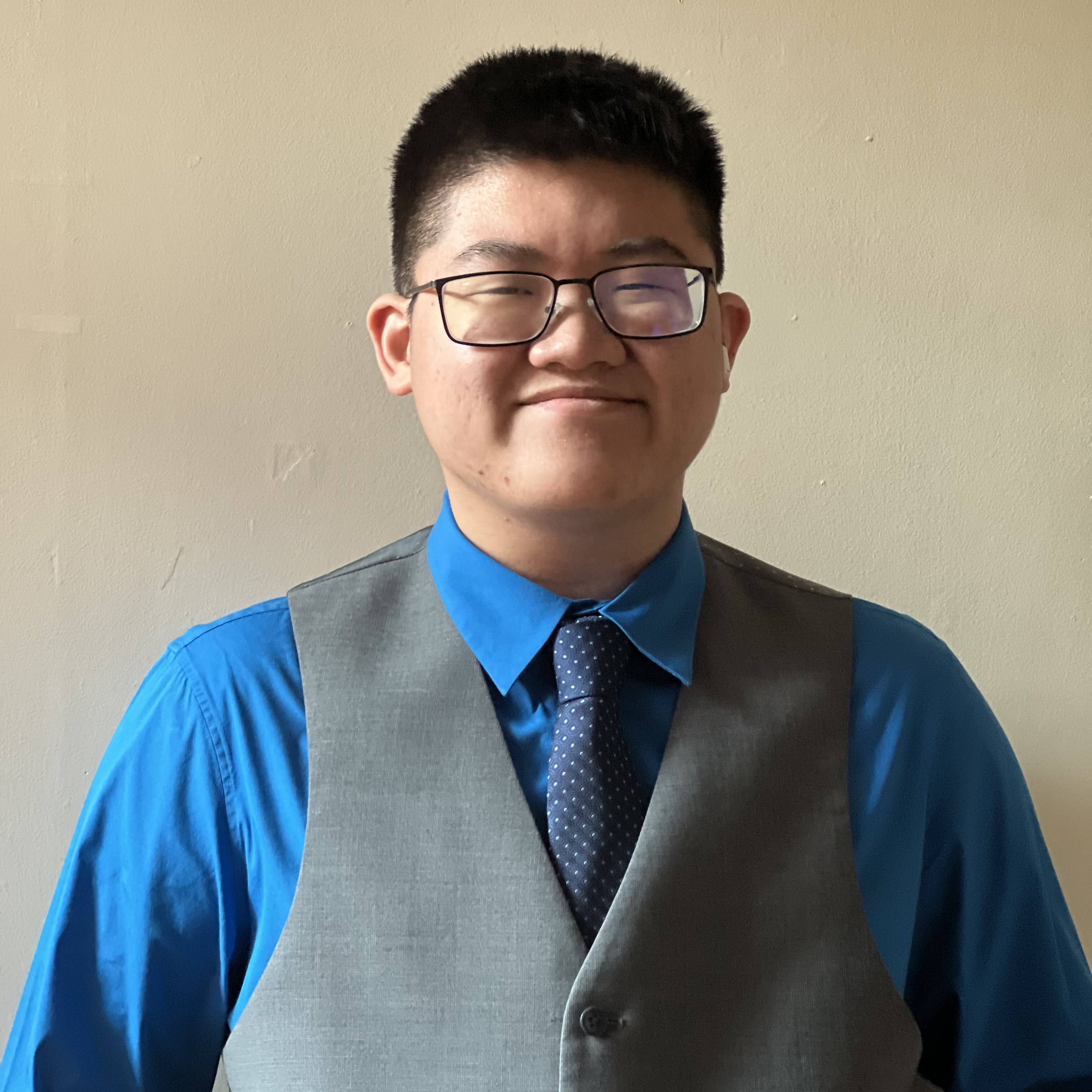
BIO
Adam Nguyen is a 4th year psychology major at FSU. His research interests revolve around understanding how to create resilient social support systems. Aside from those topics, he tends to enjoy participating in activities surrounding singing. Currently he is a part of FSU’s Tenor-Bass Acapella Group, Reverb, and FSU's auditioned choir University Singers. After his graduation, he hopes to pursue a PHD in Clinical Psychology or a Master's Degree in Clinical Mental Health Counseling.
Are Mothers Subconsciously Judged Differently Based On Everyday Parenting?
Authors: Adam Nguyen, Irmak Olcaysoy OktenStudent Major: Psychology
Mentor: Irmak Olcaysoy Okten
Mentor's Department: Department of Psychology Mentor's College: College of Arts and Sciences Co-Presenters:
Abstract
Previous work has found that people form impressions of others spontaneously and those impressions can be colored by social biases. The present study examines whether spontaneous evaluative inferences (SEIs) can be influenced by biased expectations about parenthood (i.e., motherhood and fatherhood) that have been documented previously, specifically rewarding parents that coincide with their gendered roles as caretakers (mothers) and breadwinners (fathers). Two hundred participants completed a task that measures SEIs from simple behaviors on the Prolific Academic survey platform. Specifically, participants observed 16 faces paired with a behavior entailing successful parenting, an ordinary parenting mistake, or a completely neutral behavior. The second phase instructed participants would see each face again, paired with a subliminal word, being “good or bad,” needing to use their gut reactions to ascertain which word was shown. However, no subliminal wording was programmed, rather these choices were used to measure participant SEIs. When presented with mothers, participants were more likely to select the option consistent with the result of their failures (i.e., bad) and successes (i.e., good), when compared to ones paired with neutral behaviors, indicating that SEIs were formed when reviewing mothers’ behaviors. However, SEIs for fathers were not affected by their specific behaviors as strongly. The implications of these findings postulate a societal sensitivity towards the actions of mothers, and a desensitization to the efforts of fathers. While previous work portrays parenthood in relation to social rewards and penalties, the current work suggests more complex processes for the evaluation of everyday parenthood.
Keywords: Parental Roles, Spontaneous Impressions, and Perceptions of Parenthood
25th annual Undergraduate Research Symposium, April 1, 2025
Ava Bruce Poster Session 1: 9:30 am - 10:30 am/ Poster #4
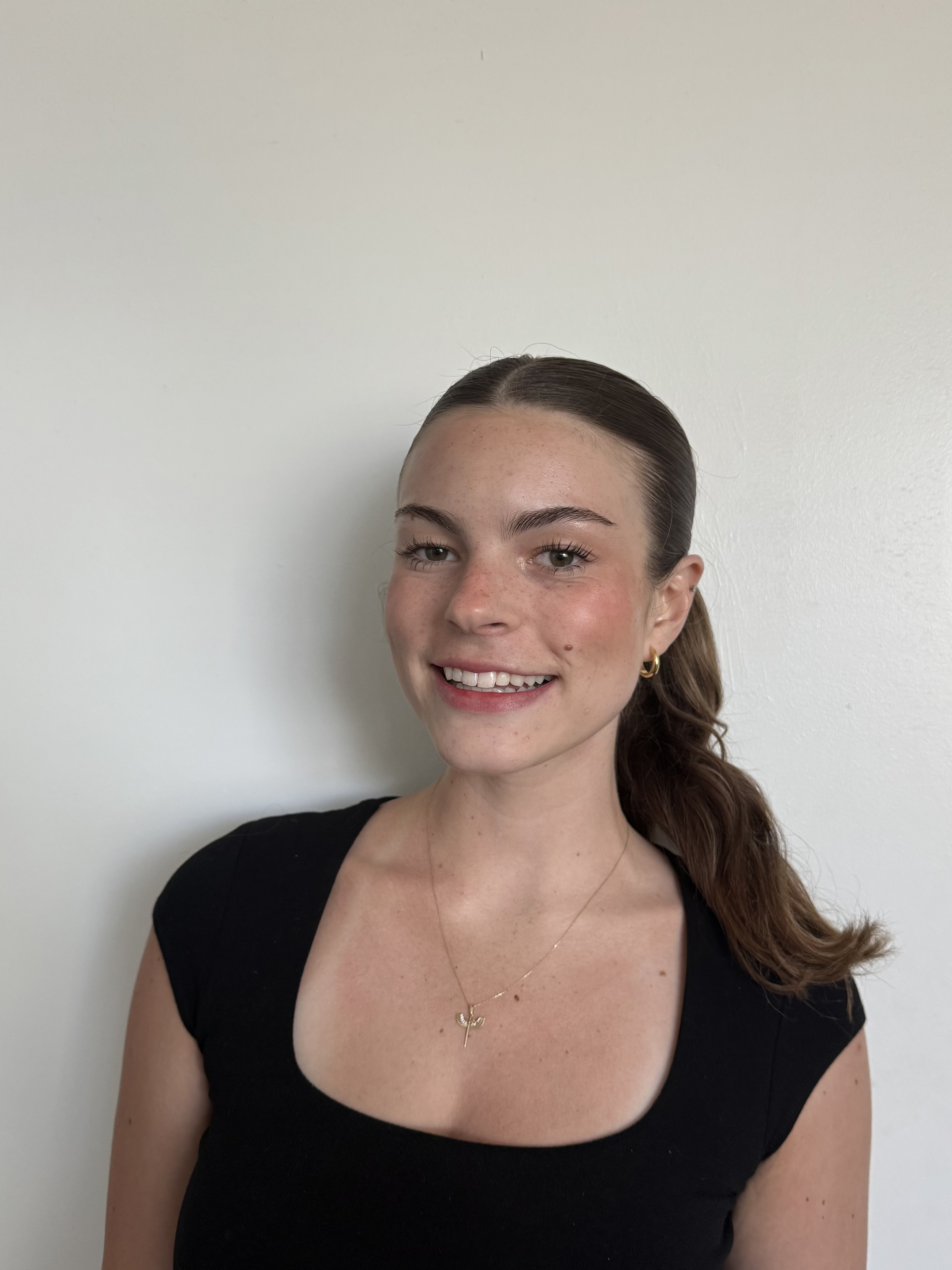
BIO
My name is Ava Bruce and I am from Jacksonville Beach, Florida. I am currently a research assistant at the Children's Learning Clinic at Florida State University and will be fulfilling a full time position as their research coordinator sometime next semester. My recent experience in research has furthered my interest in ADHD psychopathology of children. My future career goals are to continue my education and research in the field of ADHD and/or autism with children.
Differentiating Motor Activity in Depression and ADHD Among Clinically Assessed Children
Authors: Ava Bruce, Dr. Michael KoflerStudent Major: Psychology
Mentor: Dr. Michael Kofler
Mentor's Department: Psychology Mentor's College: Arts and Sciences Co-Presenters:
Abstract
Hypothesis/Objective:
Across many studies, actigraphy has served as an important tool for characterizing motor-based symptomology, such as hyperactivity, restlessness, and psychomotor activity. Whereas several studies report positive relations with cognition and functional outcomes for hyperactivity in ADHD (Kofler et al., 2018; Sarver et al., 2015) with experimental and meta-analytic evidence indicating disproportionate increases in movement among children with ADHD relative to children without ADHD (Hudec et al., 2015; Kofler et al., 2016; Rapport et al., 2009). Less is known about the functional relation between decreased motor activity in depression and impairments in working memory.
The current study explores the utility of Actigraphy as an objective measure of motor activity to differentiate movement among children with and without ADHD and depression. Understanding these distinctions may provide insights into more precise diagnostic characterization of ADHD and depression symptomology.
Method:
Motor activity was examined using Basic Motionlogger® actigraph devices during two working memory conditions (phonological and visuospatial) and two control conditions among approximately 150 clinically assessed children with and without ADHD and Depression.
Data Analytic Plan:
A 4 (between-subjects factor Group: ADHD-only, DEP-only, ADHD+DEP, Control) x 4 (within-subjects factor Task: C1, PHWM, VSWM, C2) mixed model ANOVA will be conducted to detect differences in actigraph-measured activity across conditions and diagnostic groups.
Implications:
Utilizing actigraphy as an objective measure of motor activity may allow for clarification of activity-based symptoms, such as hyperactivity and psychomotor activity, in a range of disorders.
Keywords: Actigraphy, ADHD, Depression, Movement
25th annual Undergraduate Research Symposium, April 1, 2025
Emily Czerw Poster Session 2: 10:45 am - 11:45 am/ Poster #120
BIO
My name is Emily Czerw. I am from Glen Gardner, NJ. I am a Psychology major with a minor in General Business. Next year I will be starting a master's program in Clinical Mental Health Counseling. My future goals are to work in mental health counseling and hopefully open up my own practice one day. I am very excited to continue my education in Clinical Psychology.
Examining Gender and Age Effects on Math Anxiety
Authors: Emily Czerw, Nathan LauStudent Major: Psychology
Mentor: Nathan Lau
Mentor's Department: Psychology Mentor's College: University of Waterloo Co-Presenters: ksl22a@fsu.edu
Abstract
Math anxiety is a type of anxiety, such as a feeling of tension or apprehension, that happens when faced with mathematical tasks and is generally associated with lower math achievement. Previous research has explored the influence of gender on math performance and anxiety, with some studies reporting that females reported higher levels of math anxiety than males, which could potentially impact their achievement. Additionally, some research has suggested that math anxiety emerges early within development and can vary across different age groups. However, how gender and age interact in math anxiety is currently unknown. We are looking to find the relationship between gender, age, and math anxiety in relation to math achievement. For this project, we used data collected from an ongoing longitudinal national twin project, the National Project on Achievement in Twins, and ran analyses through the RStudio database to determine which variables had a significant effect on math anxiety in math achievement. We will also consider and discuss possible limitations as well as potential future research studies. Overall, the implications of this presentation highlights the importance of preventing and addressing math anxiety through targeted solutions, especially for those that may be vulnerable due to our findings. The findings of this study will be important because with this information, students can achieve their full potential in math achievement and schools can implement programs that focus on improving math performance and confidence.
Keywords: Gender, Age, Math Anxiety
25th annual Undergraduate Research Symposium, April 1, 2025
Julia Martin Poster Session 1: 9:30 am - 10:30 am/ Poster #118
BIO
My name is Julia Martin. I am a junior from Auburn, New Hampshire, studying Biomedical Engineering at the FAMU-FSU College of Engineering. Currently, I work as an undergraduate research assistant in the NMR department at the National High Magnetic Field Laboratory, where I focus on RF coil evaluation and MRI sample preparation. My academic interests include computer-aided design (CAD), bioinstrumentation, and image processing. I am excited to further explore these areas through the NHMFL REU program this summer, where I will continue working on RF coil optimization for high-field MRI applications.
Sample Testing and Preparation for 21.1T MRI Applications
Authors: Julia Martin, Malathy ElumalaiStudent Major: Biomedical Engineering
Mentor: Malathy Elumalai
Mentor's Department: CIMAR, NMR Mentor's College: National High Magnetic Field Laboratory Co-Presenters:
Abstract
The 21.1T magnet at the National High Magnetic Field Laboratory (NHMFL) is the world’s most powerful Magnetic Resonance Imaging (MRI) system, enabling high-resolution imaging of biological and physical samples. This project focused on learning techniques in MRI sample preparation, including phantom formulation, cryogenic storage, bench evaluation with radio frequency (RF) coils, and testing in the 21.1T magnet. Three studies were conducted to enhance MRI protocols: preparation of potassium chloride (KCl) samples to evaluate a 39K MRI RF coil, development of a cryogenic dipper for long-term sample storage at 77K, and MRI evaluation of phantoms in the magnet to optimize imaging quality. Experimental results demonstrated the feasibility of 39K imaging at ultra-high fields and highlighted the importance of precise sample handling and cryogenic techniques in MRI research. These findings aims to improve imaging protocols and enhance the use of high-field MRI for biomedical applications.
Keywords: RF Coil, MRI, Biomedical Engineering
25th annual Undergraduate Research Symposium, April 1, 2025
Connor Meadows Poster Session 2: 10:45 am - 11:45 am/ Poster #138

BIO
My name is Connor Meadows, and I’m a first-year Finance major in the Honors Program at Florida State University. I’m originally from Eden Prairie, Minnesota, and I chose FSU for its strong academic opportunities and vibrant campus life. Outside the classroom, I enjoy volunteering, weightlifting, and playing basketball. Whether I’m helping out in the community or staying active with friends, I value staying engaged and pushing myself to grow. After college, I plan to pursue a career in wealth management or banking, where I can build meaningful relationships and help clients reach their financial goals.
The Big Push: Federal Road Building in the Early Days of the Automobile
Authors: Connor Meadows, Dr. William CockrielStudent Major: Finance
Mentor: Dr. William Cockriel
Mentor's Department: Department of Economics Mentor's College: University of Chicago Co-Presenters: Jody Lin and Anthony Menold
Abstract
The objective of this study is to examine the distribution of government-provided road funding across various states in the early 20th century, as automobiles began revolutionizing the United States economy. The Federal Aid Road Act of 1916 paved the way for cars throughout the U.S. by funding road-building projects proposed by state governments. Some states and counties proposed large, expensive projects but received less funding from the federal government compared to other state projects. The study relied on data entry from reports published by the U.S. Department of Agriculture. Using this new data source, heat maps were created to visually display what areas in the country had the highest cost in road building. In addition, Excel graphs that use plots of total costs and total aid suggest that Kansas, Texas, and Illinois proposed the highest-cost projects. However, Missouri, Pennsylvania, and New York received the most federal aid. Ultimately, the results of this study will lay the foundation for further research in the future, such as what economic factors were present at the time of construction, which could answer how these roads influenced automobile adoption, economic development, and productivity. While this research has answered the “what” concerning the dispersions of road cost and aid, future observations can answer the “why?”
Keywords: Road, Federal Aid, Construction, Research
25th annual Undergraduate Research Symposium, April 1, 2025
Jacob Gooding Poster Session 4: 3:00 pm - 4:00 pm/ Poster #71

BIO
My name is Jacob Gooding. I am a second year political science and psychology student at Florida State University. I was born in Charleston, South Carolina, but have lived here in Tallahassee, Florida since 2015. My research focuses on the effects of the Supreme Court case Shelby County v. Holder on minority voter turnout in red states. My own research interests focus on the intersection of political science and psychology, or how our political decisions are shaped by our minds. After graduation I hope to pursue a masters and eventually a doctorate.
How Community Organizations Facilitate Democracy Post-Shelby County v. Holder
Authors: Jacob Gooding, JoVontae ButtsStudent Major: Political Science, Psychology
Mentor: JoVontae Butts
Mentor's Department: Sociology Mentor's College: Florida State University Co-Presenters:
Abstract
This study focuses on a mid-size city in a Republican-controlled state in the southeastern United States, a region where voter suppression tactics were expected to be particularly aggressive during the 2024 election season, given its history of racialized voter suppression and the current political landscape. While much research has been conducted on voter mobilization strategies, there remains a significant gap in the literature specifically focused on how to effectively engage and mobilize marginalized voting populations. This research aims to address this gap by conducting an ethnographic examination of organizations and campaigns that work to enfranchise all voters. This research explores the strategies employed by organizations and campaigns to overcome the barriers that hinder voter participation. It seeks to answer critical questions: How do organizers address the conditions that most likely prevent individuals from exercising their right to vote? How do they access and engage racially or economically oppressed voters who are often disengaged? And how do canvassers help these individuals develop a civic identity? Through participant observation and semi-structured interviews, this project provides a nuanced understanding of the efforts and effectiveness of grassroots mobilization strategies in the post-Shelby County v. Holder era. By focusing on the lived experiences of both organizers and voters, particularly within economically oppressed communities, this research will contribute valuable insights into how to ensure a more inclusive and participatory democratic process for those who have been historically marginalized.
Keywords: elections, voting, civil engagement, sociology


